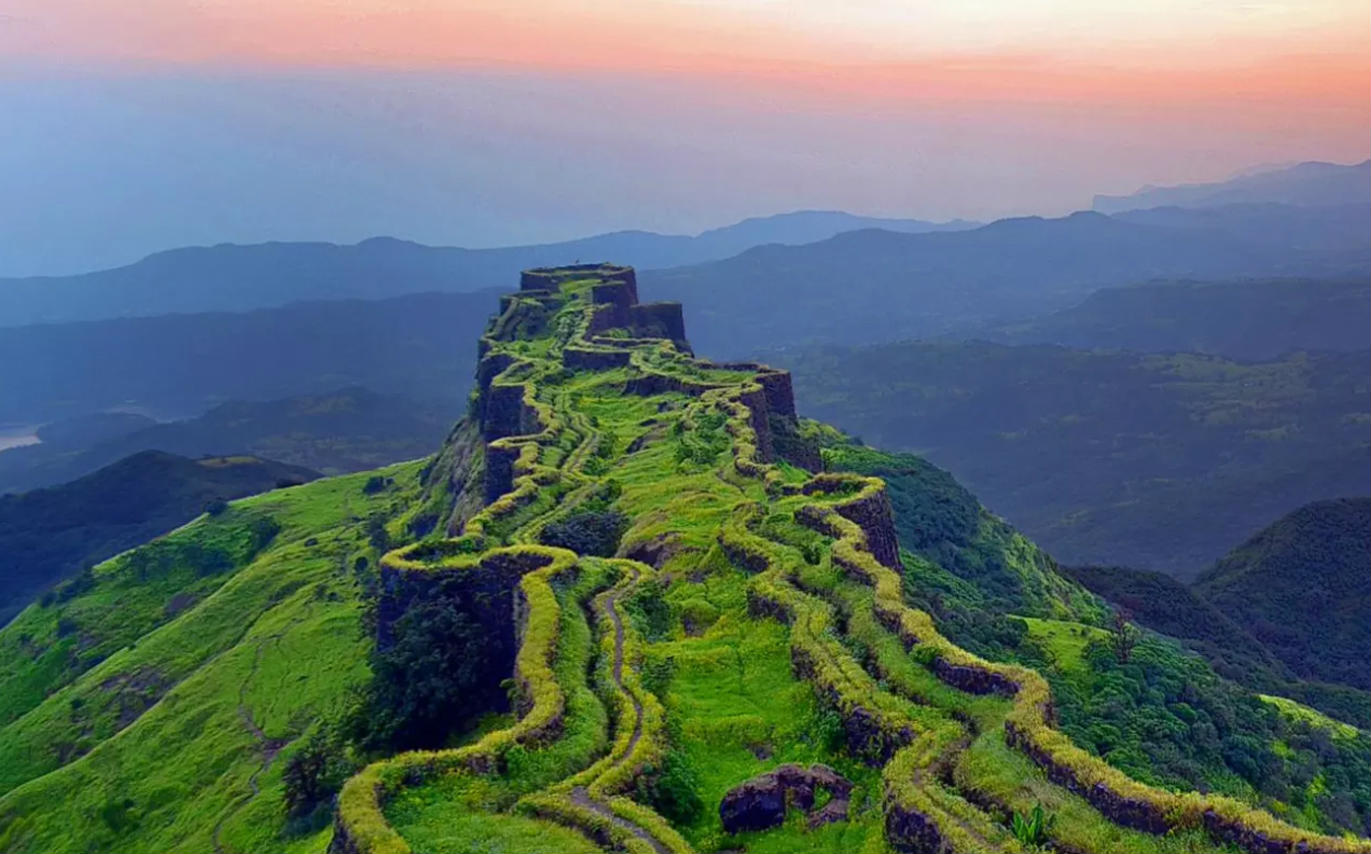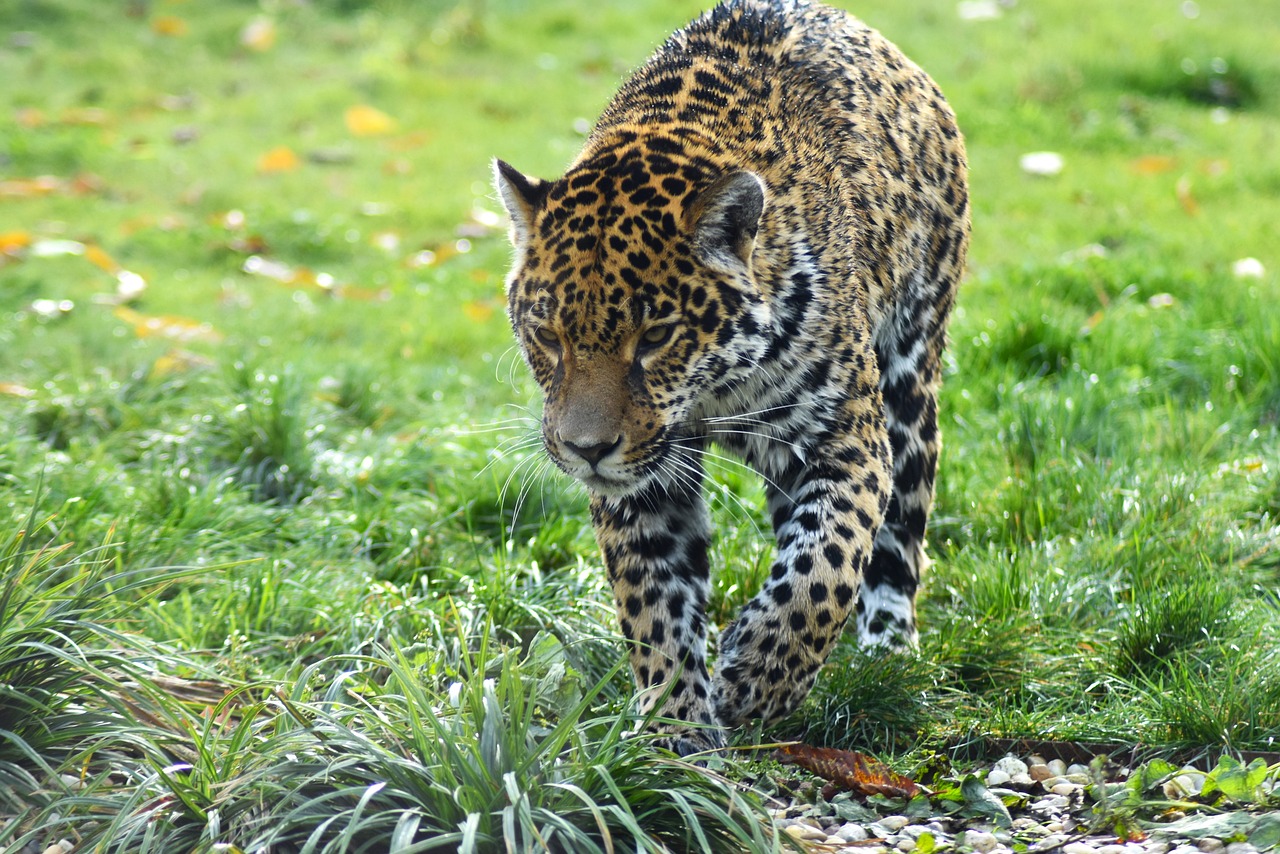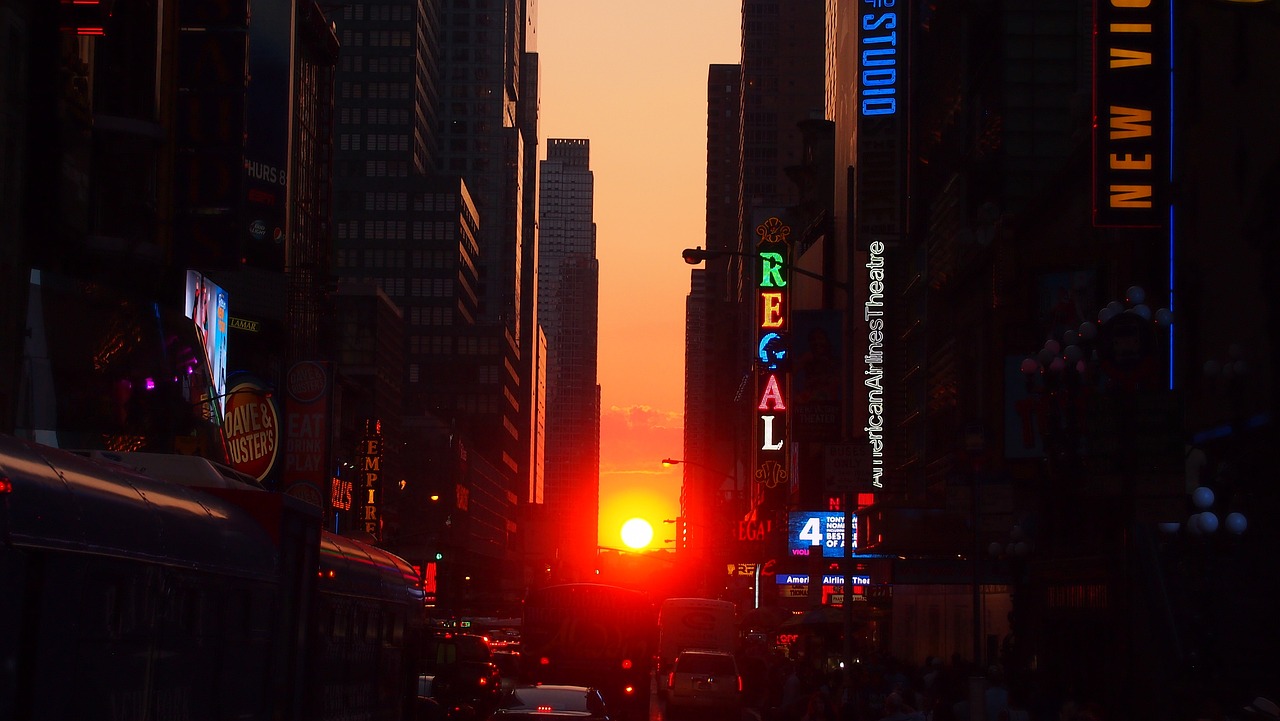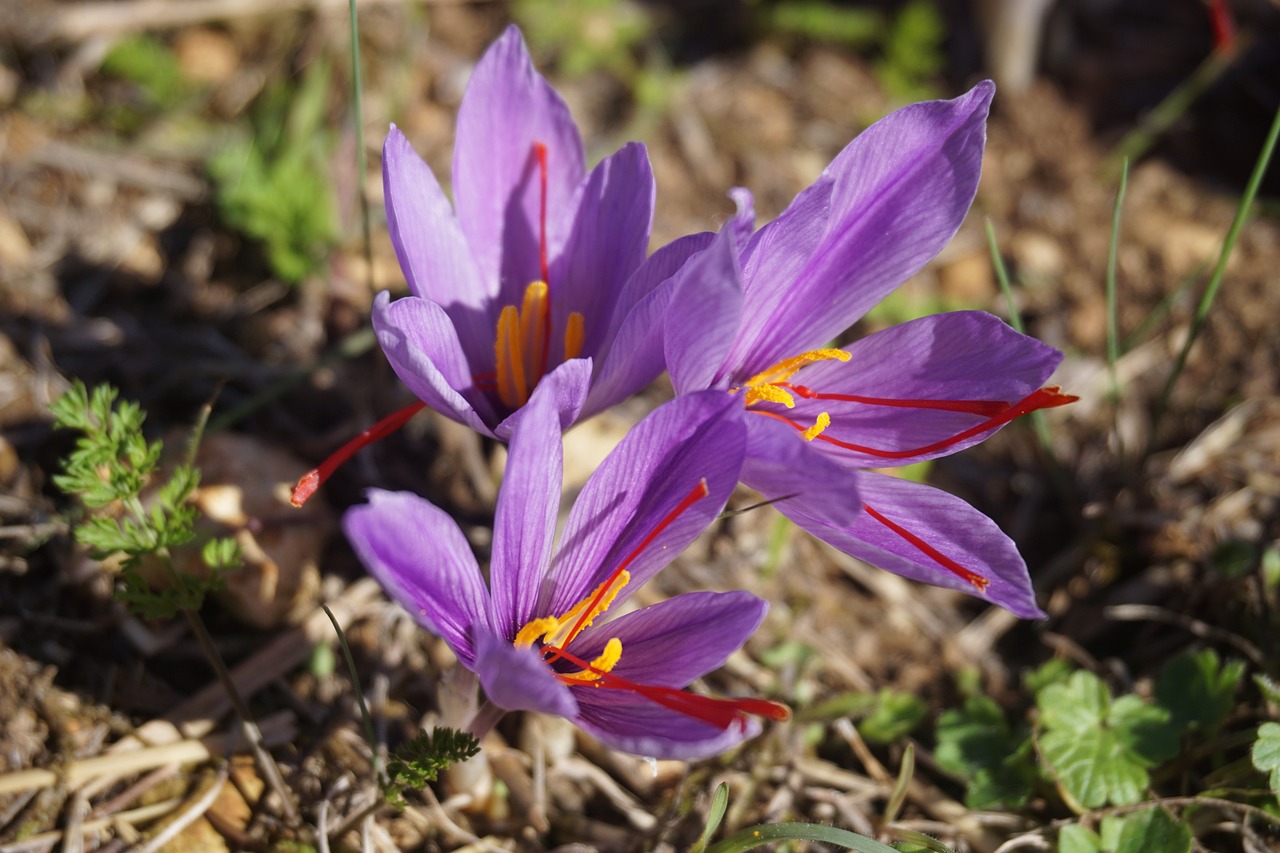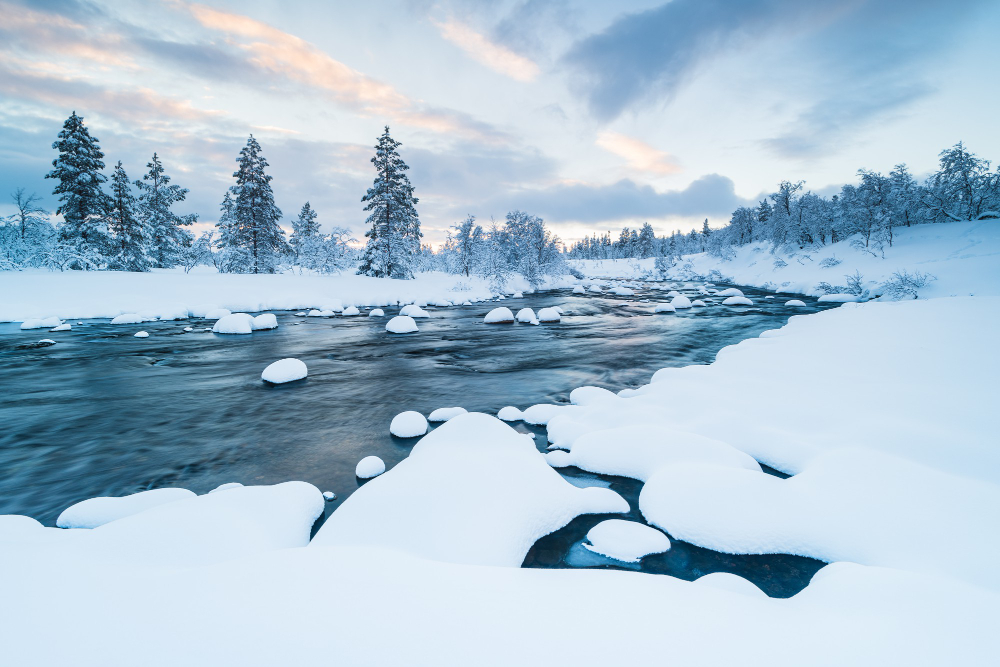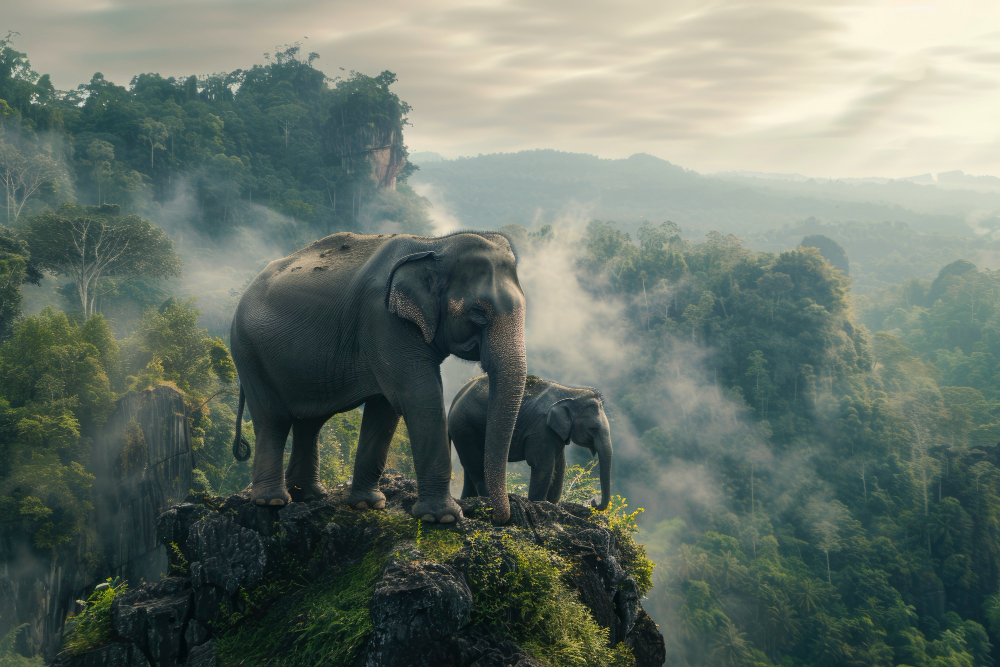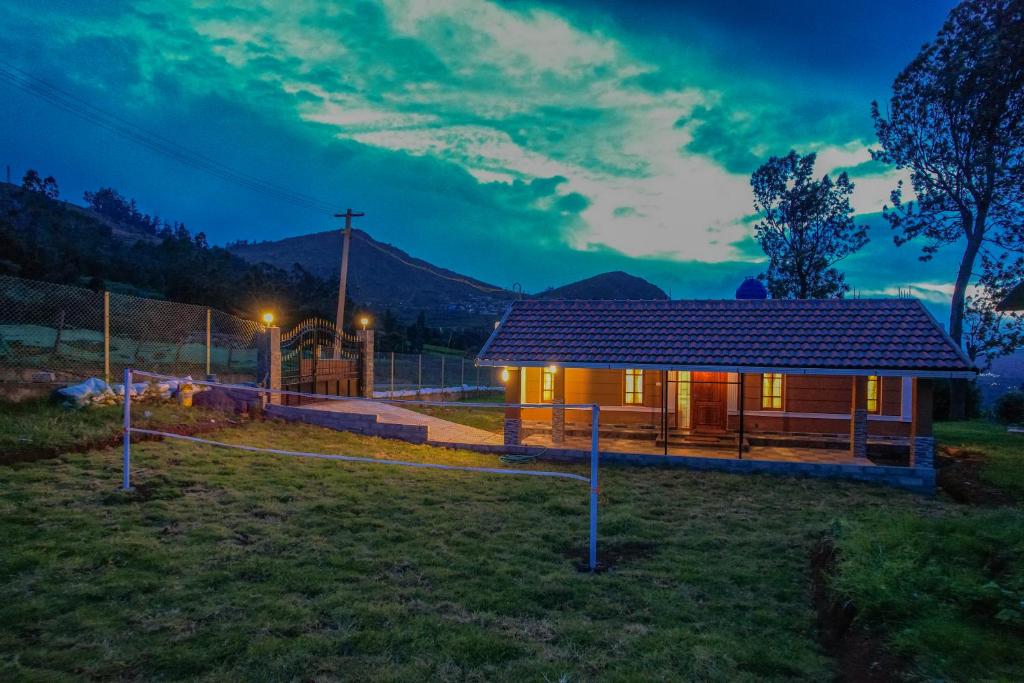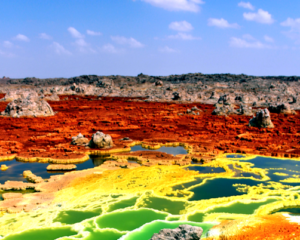A journey around the world is the ultimate adventure for many. With an endless array of vibrant cultures, breathtaking landscapes, and unforgettable activities, compiling a travel bucket list can be as thrilling as the experiences themselves. Here are 25 epic experiences to fuel your wanderlust and inspire your next globe-trotting escapade.
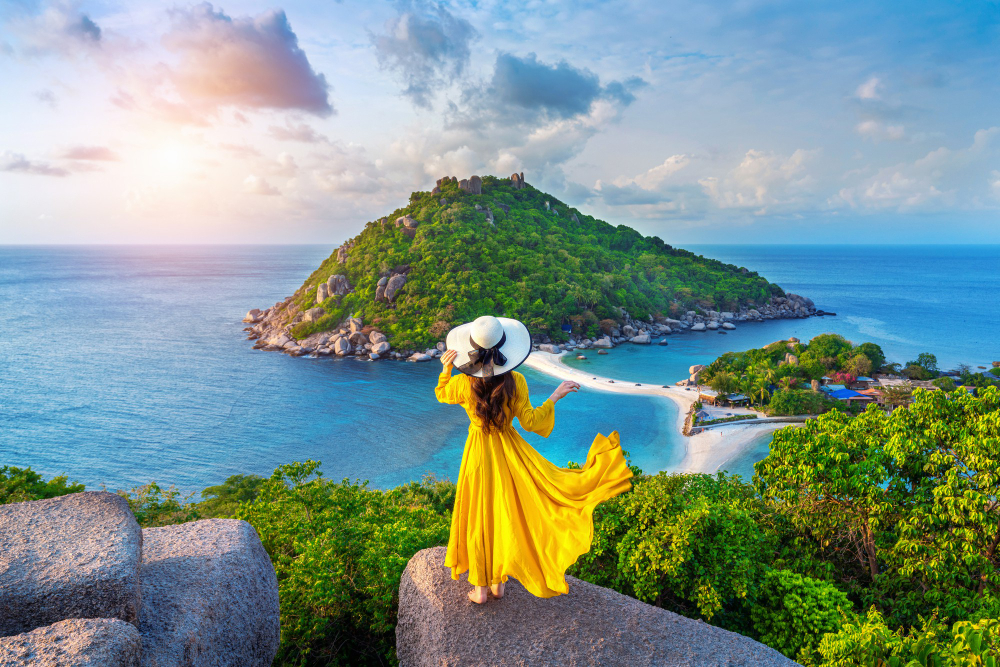 Pin
Pin Image by: Freepik.com
Table of Contents
1. Witnessing the Great Migration in Serengeti, Tanzania: A Symphony of Life on the Move
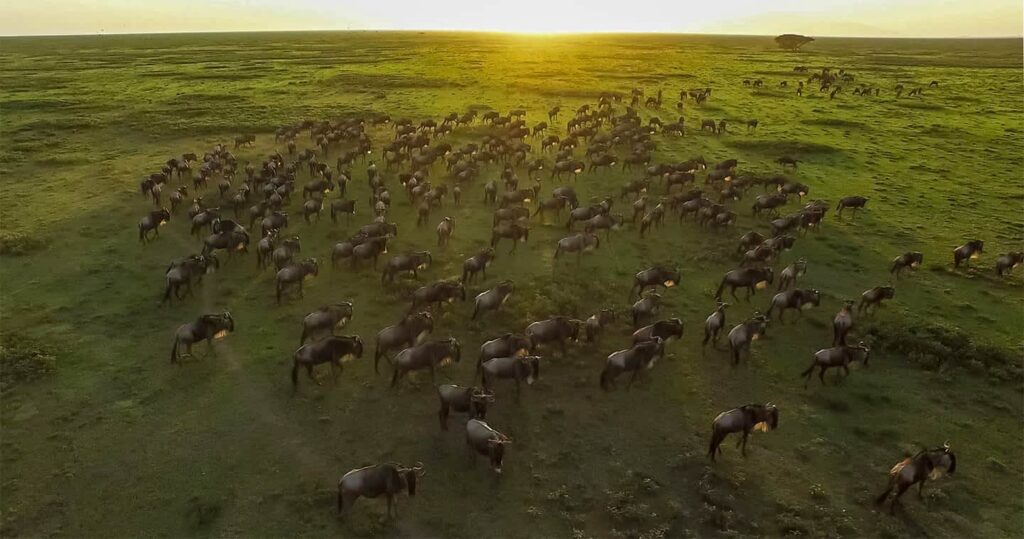 Pin
Pin Image by : PublicDomainPictures from Pixabay
Every year, over a million wildebeest and zebras traverse the plains in a spectacular display of natural wonder.
Experience the primal heartbeat of Africa by witnessing one of the world’s most awe-inspiring natural events – the Great Migration in the vast plains of the Serengeti in Tanzania. This ancient and monumental journey is one of the last mass terrestrial wildlife movements on the planet, evoking a sense of wonder at the sheer scale and instinctive ritual that has played out for eons.
Each year, as the seasons turn, over a million wildebeest accompanied by hundreds of thousands of zebras and gazelles set out on a cyclical quest for food and water. Their journey is a perilous trek across 1,200 miles that includes crossing treacherous rivers with lurking crocodiles, facing predators such as lions, cheetahs, and hyenas on the land, and the relentless challenge of the elements.
The migration typically begins in the Ngorongoro Conservation Area of the southern Serengeti in Tanzania, where calving season sees hundreds of thousands of wildebeest born in a synchronized birthing meant to swamp predators and increase the chances of survival. As the dry season approaches, the vast herds are spurred northwards towards the fresh pastures of the Masai Mara in Kenya.
One of the most thrilling sights is the crossings of the Grumeti and Mara rivers, where the sheer cliff faces and powerful currents add to the chaos of the crossing, and survival is far from guaranteed. The scenes of immense herds congregating, the nervous tension, and the explosive bursts of action provide a spectacle that is raw, dramatic, and profoundly moving.
Aside from the large migrators, the Great Migration also influences a whole host of other wildlife interactions and migrations, creating a dynamic ecosystem that supports large predators and scavengers, as well as a variety of other animals and plant life.
For the local Maasai communities, the migration represents a vital part of their culture and heritage, a phenomenon that their lives have been intertwined with for centuries. Opportunities abound for visitors to engage with Maasai guides and gain insight into their traditional ways of life, bolstering a more profound appreciation for this natural phenomenon through the lens of indigenous knowledge.
To witness the Great Migration is to see the workings of an ecosystem in its most spectacular form. It’s a chance to be immersed in the unedited version of nature’s ebb and flow, offering a perspective that reaches beyond the immediate visual feast to touch on the continuity of life, the struggle for survival, and the interconnectedness of species on the African savannah.
For travelers and nature enthusiasts, the Great Migration embodies the essence of a raw and untamed world, epitomizing the spirit of a bucket list experience that resonates with the core of our very being, bearing testament to the enduring wonder of the natural world.
2. Explore the Galapagos Islands, Ecuador
Encounter unique wildlife that’s unafraid of humans in this volcanic archipelago. The Galapagos Islands represent a mesmerizing microcosm of our planet’s ecological diversity. Lying some 600 miles off the coast of Ecuador in the Pacific Ocean, this volcanic archipelago is home to an array of unique wildlife species whose evolutionary adaptations have captured the fascination of scientists and nature enthusiasts alike.
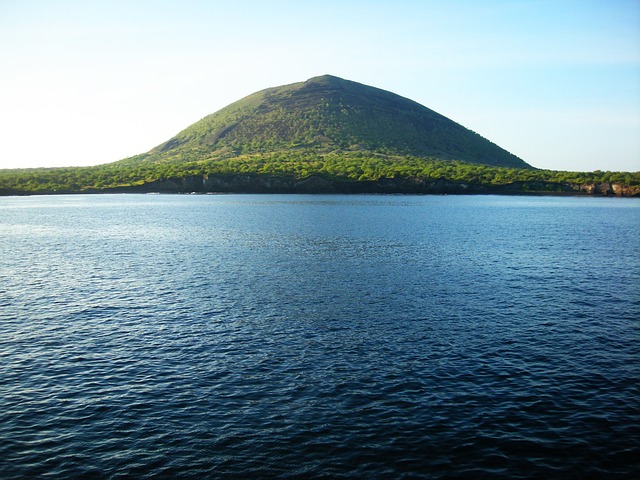 Pin
Pin Image by : PublicDomainPictures from Pixabay
Encountering the Wildlife: The animals in the Galapagos have little fear of humans, which is perhaps the most compelling aspect of wildlife encounters here. This lack of fear seems rooted in the fact that the islands have long been isolated and free from human predators. The result is an extraordinary opportunity for visitors to observe and interact with wildlife at a close range that is nearly impossible elsewhere in the world.
Endemic Species: Many of the species found in the Galapagos can’t be found anywhere else on Earth. From the iconic giant tortoises, which gave the islands their name (‘galapago’ means ‘tortoise’ in Spanish), to the marine iguanas, the only sea-going lizards in the world, the islands are a living exhibit of evolution in action.
Birdwatching Haven: For bird enthusiasts, the islands have a particular allure. Among the most famous are the blue-footed boobies, with their distinctively colored feet, the magnificent frigatebirds with their bright red throat pouches, and the various species of Darwin’s finches, each with a beak shape adapted to its specific dietary niche.
Marine Encounters: Marine life is similarly impressive. Snorkelers and divers may find themselves swimming alongside playful sea lions, gliding past ancient sea turtles, or observing the antics of penguins – an unexpected sight this close to the equator.
Conservation Efforts: The Galapagos are groundbreaking in their focus on ecological conservation. The islands are a UNESCO World Heritage site. Strict rules regulate tourism, fishing, and residency, reflecting the Ecuadorian government and various international organizations’ commitment to preserve this unique ecosystem.
Evolving Landscape: The islands themselves are a showcase of volcanic activity. Visitors can hike to the rims of active volcanoes, traverse fields of petrified lava, and explore the unique flora that has taken root in this harsh, lava-formed environment.
For those penning an article about the Galapagos, it is essential to convey the sense of otherworldly wonder that grips visitors. The interplay of volcanic geology, isolation, unique flora and fauna, and committed conservation combines to create a destination like no other – a living laboratory that continues to provide invaluable insights into our planet’s biological and ecological heritage.
3. Soak in the Blue Lagoon, Iceland
Relax in geothermal waters surrounded by icy landscapes.
At the heart of Iceland’s dramatic landscapes lies the Blue Lagoon, an ethereal oasis that invites visitors to immerse themselves in its warm, milky-blue waters. The lagoon, set against a backdrop of rugged lava fields and icy scenery, offers a stark contrast that epitomizes the land of fire and ice.
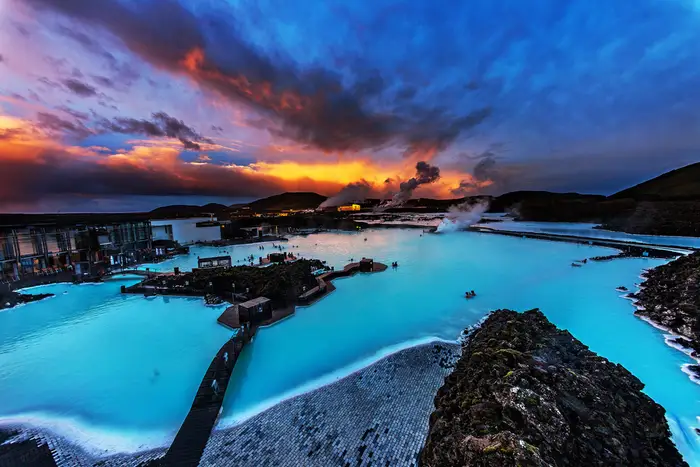 Pin
Pin Image Credit: www.businessinsider.com
The primary allure of the Blue Lagoon is its geothermal waters, rich in minerals like silica and sulphur. Known for their healing properties and beneficial effects on the skin, these mineral-rich waters are naturally heated by the earth’s geothermal energy, maintaining a comforting temperature of 37-40°C (98-104°F) year-round. This perfect warmth offers relief from Iceland’s chilly air, making it an inviting sanctuary from the harsh Arctic climate.
As you step into the lagoon, the steam rising from the water meets the cool Icelandic air, creating a mystical ambiance that seems to transport you to another world. With every pore-opening moment in the water, visitors often describe a sense of their stresses melting away, as they bask in the therapeutic embrace of nature’s own spa.
The surrounding icy landscapes offer a visual spectacle that is uniquely captivating. In the midst of winter, the contrast between the warm waters and the snow-covered black lava rocks is spellbinding. When the northern lights streak across the night sky, the experience becomes truly otherworldly, as the shimmering colors reflect off the silvery surface of the lagoon.
Sustainability is key to the operations at the Blue Lagoon. The geothermal water originates from deep beneath the surface, a byproduct of the nearby Svartsengi geothermal power plant. After generating electricity, the superheated water is fed into the lagoon, ensuring that nothing is wasted in this eco-friendly process.
To enhance relaxation, the Blue Lagoon offers various in-water treatments, including silica mud masks, which are included in the admission. These masks leave your skin feeling soft and rejuvenated. For an extra dose of luxury, visitors can indulge in massages and spa treatments conducted in the serene privacy of the lagoon’s waters.
The Blue Lagoon isn’t solely about individual relaxation—it also caters to social experiences. There’s a sense of shared wonder among visitors, whether they’re solo travelers, couples, or families. Conversations often spark easily in the congenial atmosphere, perhaps over a drink from the in-water bar, which serves smoothies, cocktails, and other refreshments.
In planning a visit to the Blue Lagoon, there are practical considerations to ensure a comfortable experience. Pre-booking a time slot is essential as it is one of Iceland’s most popular attractions. Facilities such as locker rooms, restaurants, and an on-site hotel offer all the amenities needed for a day of indulgence.
Floating in the warm embrace of the Blue Lagoon, surrounded by a land that oscillates between extremes of ice and fire, you’ll find a moment of pure tranquility that is quintessentially Icelandic—an encounter with nature that’s both invigorating and soothing.
4. Trek to Machu Picchu, Peru
Hike the Inca Trail to uncover the mysteries of this ancient citadel.
The Inca Trail to Machu Picchu is more than a mere hike; it’s a journey through history and spirituality, one that unveils the enigmatic aura of ancient Inca civilization.
Historical Significance: Machu Picchu, often referred to as the “Lost City of the Incas,” is a monumental relic of the Inca Empire’s might and ingenuity. Built in the 15th century, it was abandoned during the Spanish Conquest and remained hidden from the outside world until its rediscovery by Hiram Bingham in 1911. Hiking the Inca Trail offers a vivid narrative of Incan history, with each step aligning with the footprints of a civilization that once masterfully harmonized architecture with the rugged Andean landscapes.
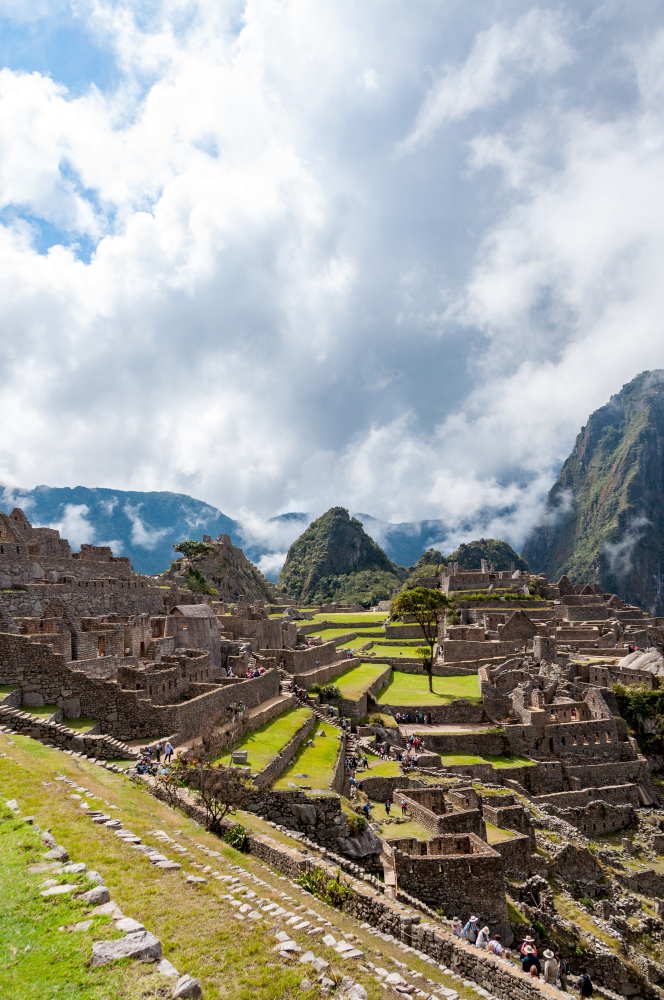 Pin
Pin Image by: Freepik.com
The Inca Trail: The classical Inca Trail is an approximately 43-kilometer (26-mile) trek, usually undertaken in four days and three nights. This ancient path meanders through the Sacred Valley, passing numerous archaeological sites such as Runkurakay, Sayacmarca, and Phuyupatamarca before reaching the Sun Gate (Intipunku) of Machu Picchu. The trail’s elevation changes are dramatic, including the formidable Dead Woman’s Pass at 4,215 meters (13,829 feet) above sea level.
Flora and Fauna: The route traverses diverse ecological zones from high-alpine to cloud forests, allowing trekkers to witness a variety of plant species, including orchids and the iconic queñua tree. Wildlife is equally diverse, with the possibility of encountering spectacled bears, Andean condors, and a plethora of hummingbird species.
Mystical Experience: Many describe the trek as a spiritual encounter. Isolated from modern distractions, the hike stimulates introspection and a profound connection with nature. The culmination of the trail at sunrise by the Sun Gate affords a transcendent first glimpse of Machu Picchu, often shrouded in mist, that leaves an indelible mark on the soul.
Logistical Considerations: Peru’s government regulates access to maintain the trail’s integrity, limiting the number of hikers. Permits sell out months in advance, hence early planning is crucial. Trekkers typically book through tour operators, who provide guides, porters, and cooks, ensuring a focus on the experience without the burdens of logistics. Physical preparation is essential as the trail is demanding, and altitude can affect even the fittest adventurers.
Best Time to Hike: The ideal months for trekking are from May to September, during the dry season, offering clear skies and temperate weather. The trail is closed in February for maintenance.
Reflections: Completing the trek, one is left with more than photographs. The experience is a mosaic of natural beauty, physical challenge, cultural immersion, and personal enlightenment. Uncovering the mysteries of Machu Picchu by walking the Inca Trail is an unparalleled way to connect with the past and discover the timeless allure of the Peruvian Andes.
The journey to Machu Picchu is akin to reading a living history book, where each chapter is a step, each page turn a new view, and by the end, the final revelation is actually a beginning—a new understanding of the Inca legacy and a personal sense of accomplishment.
5. Admire the Northern Lights, Various Locations
Witness the sky dance with colors in places like Norway, Iceland, and Canada.
The Northern Lights, or Aurora Borealis, offer one of the most captivating natural spectacles in the world, with skies that dance with colors ranging from green to violet. Understanding the aurora begins with the sun, which emits a stream of charged particles known as the solar wind. When these particles collide with the Earth’s magnetosphere, they excite atmospheric gases, causing them to glow and create the auroras.
 Pin
Pin Image Credit: Mollyroselee from Pixabay
Norway is one of the premier destinations for viewing the Northern Lights, particularly in areas above the Arctic Circle, like Tromsø. Here, the auroras frequently illuminate the night sky from early autumn to early spring. The juxtaposition of the lights against the rugged Norwegian coastline and mountainous terrain creates a dramatic backdrop for this celestial show.
Iceland is one of the premier destinations for viewing the Northern Lights, particularly in areas above the Arctic Circle, like Tromsø. Here, the auroras frequently illuminate the night sky from early autumn to early spring. The juxtaposition of the lights against the rugged Norwegian coastline and mountainous terrain creates a dramatic backdrop for this celestial show.
Canada’s vast wilderness areas, particularly in the Yukon, Northwest Territories, and Nunavut, serve as ideal settings to witness the auroras. Far from light pollution, the clear and expansive skies in these regions make for exceptional viewing conditions. Places like Yellowknife offer “aurora tourism” with a range of experiences from cozy cabins to ice hotels.
Tips for aurora watchers include dressing warmly in layers, as aurora locations are generally in cold environments; checking aurora forecasts and solar activity; and planning trips around the new moon phase for the darkest skies. Additionally, staying for several days can increase the chance of seeing the lights, as they are notoriously unpredictable.
The Northern Lights are not only a bucket-list experience but also carry cultural significance for many indigenous peoples in these regions, often reflected in folklore and art. Today, however, they draw people from all corners of the globe, uniting them under the awe-inspiring, mystical dance of colors in the night sky.
6. Venture into the Amazon Rainforest
Experience the world’s largest tropical rainforest and its incredible biodiversity.
The Amazon Rainforest represents the zenith of natural diversity, a vast and teeming trove of life unparalleled anywhere else on Earth. Covering over 5.5 million square kilometers, this immense forest spans nine countries, with the majority in Brazil, Peru, and Colombia.
Immense Biodiversity: The Amazon is the most biodiverse rainforest, hosting approximately 10% of the world’s known species. It is home to an estimated 390 billion individual trees, divided among 16,000 species. The faunal variety is staggering, with over 2,500 types of fish, 1,300 bird species, 430+ mammals, 1,000+ amphibians, and around 400 reptiles. Iconic species like the jaguar, the green anaconda, the Amazon river dolphin (pink dolphin), the poison dart frog, and countless others fill every ecological niche.
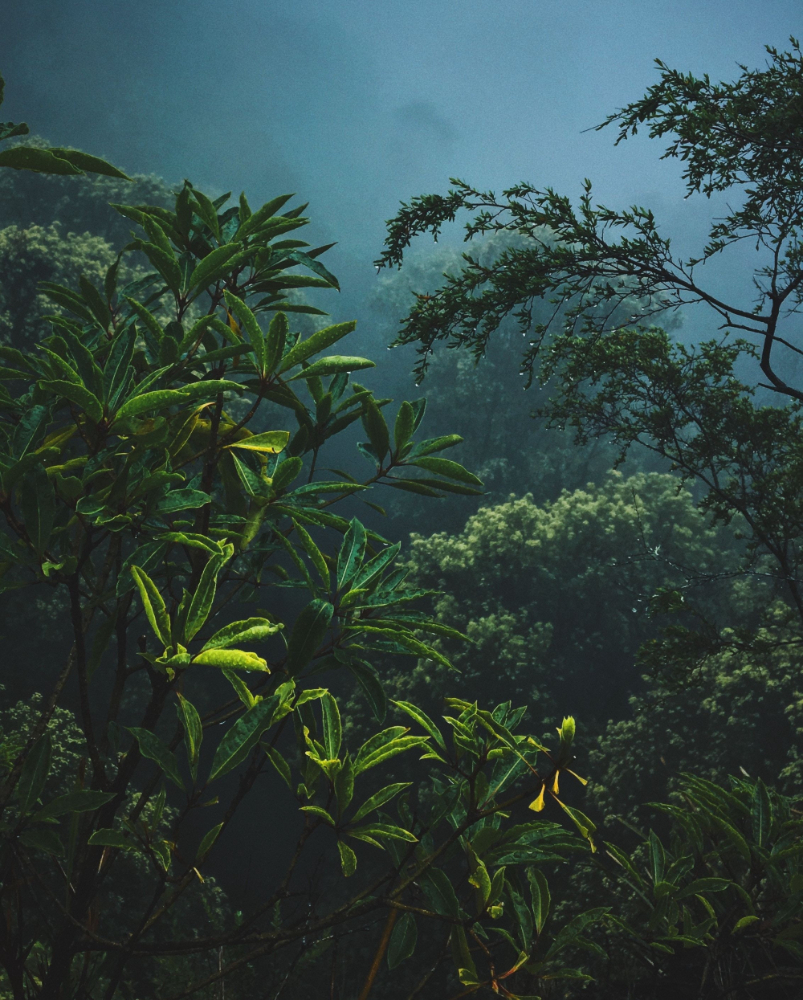 Pin
Pin Image Credit: wirestock from Pixabay
The Green Ocean: This rainforest is often called the “lungs of the planet” due to its ability to absorb massive amounts of carbon dioxide and release oxygen. Indeed, the Amazon is a key component in global climate regulation. Standing within its borders, one is surrounded by an endless canopy of green, with emergent trees standing 50 meters and higher above the forest floor.
Indigenous Cultures: Over 400 indigenous tribes with rich and varied cultures call the Amazon their home. Many of these communities continue traditional ways of life that are harmoniously intertwined with the rainforest, relying on its resources for food, shelter, and medicine. They are also the forest’s best stewards, defending its biodiversity against threats.
River of Life: The Amazon River, the second-longest river in the world, snakes through this rainforest, acting as a vital waterway. Its basin holds a fifth of the world’s fresh river water. A venture along this river can reveal the rainforest’s splendor, from pink river dolphins to the elusive caiman, and the cacophony of bird calls each morning.
Threats and Conservation: Unfortunately, the Amazon faces significant threats from deforestation, illegal mining, and agriculture, which are destroying important areas of the forest. These actions are not only a loss of habitat for wildlife but displace indigenous communities and contribute significantly to climate change. Efforts to preserve the Amazon are critical, involving local and international pressure, conservation projects, and sustainable development initiatives.
Adventure and Discovery: For the intrepid traveler, an expedition into the Amazon is a plunge into the heart of wilderness. Lodges and guided tours provide opportunities for wildlife viewing, photographic expeditions, canopy walks, and even encounters with local tribes. Each experience is a personal encounter with one of the most powerful expressions of life on our planet.
The Amazon’s value is intrinsic, immeasurable, and it’s an irreplaceable source of life and culture. Venturing into this rainforest is more than just a trip; it’s an immersion into a complex ecosystem that sustains our planet in ways we are still trying to fully understand. It is one of the true adventures left in this increasingly homogenized world.
7. Walk the Great Wall of China
Spanning thousands of miles, it’s a testament to human endeavor.
The Great Wall of China is an awe-inspiring feat of ancient engineering that snakes across northern China, covering vast and varied terrains. It stands as a testament to human endeavor, symbolizing not only the strength and determination of a civilization to protect itself but also its capacity for monumental and enduring construction.
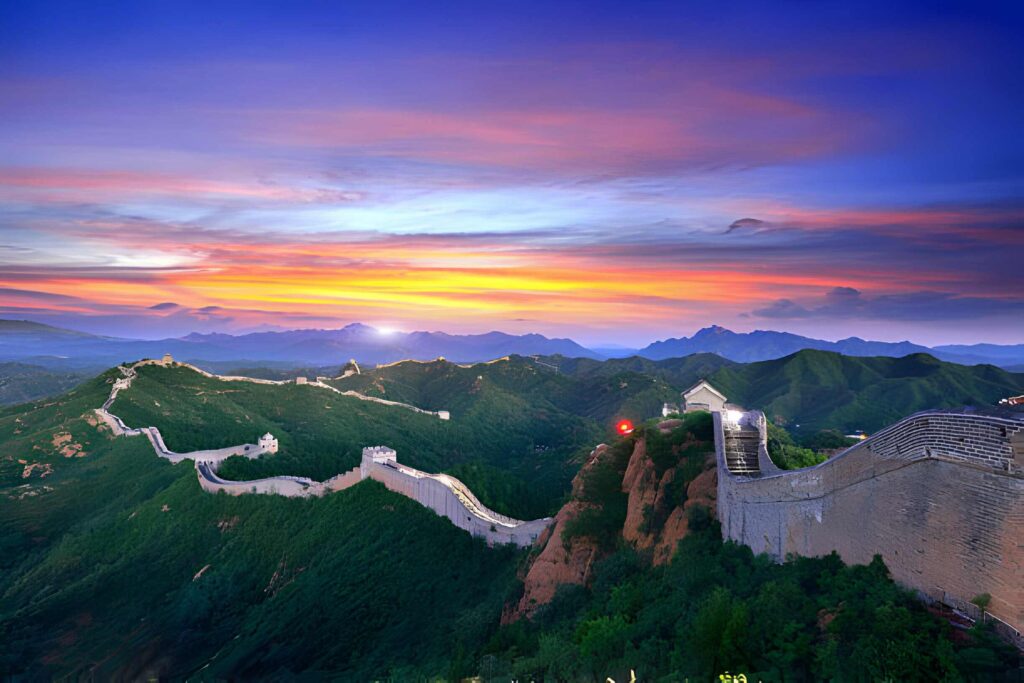 Pin
Pin Image Credit: istock.com
Historically, the Great Wall was built over several centuries, with work starting as early as the 7th century BC. The majority of the existing structure, often referred to when talking about the Great Wall, was built during the Ming Dynasty (1368–1644 AD). The primary purpose of the wall was to protect the Chinese empire from northern invasions by nomadic tribes. Over time, it also served to regulate trade along the Silk Road, assist in border controls, and enforce the imposition of duties on goods transported along the Silk Road.
Extending over 21,000 kilometers (13,000 miles), its length is often contested due to various dynasties adding and rebuilding sections — some parts have disappeared over time, while others remain submerged under water. Deserts, plains, mountains, and plateaus all feature as part of the Wall’s backdrop, presenting a cross-section of China’s diverse geography.
From towering heights reaching the clouds at Heita Mountain to the waves lapping at its bricks at Shanhaiguan, where the Wall meets the sea, the Great Wall offers a variety of experiences. The sections of the Wall that are best known and frequently visited are close to Beijing, such as Badaling and Mutianyu. These have been restored and are easier to walk. However, there are other sections like Jiankou, which are known for their wild beauty but can be dangerous to traverse.
Walking on the Great Wall is an experience of history in motion. Each step along the ancient stones is a step back in time, pondering the lives of soldiers, builders, and emperors who once set foot upon these same crenellations. Moreover, the Wall is not just one continuous line but a network of walls, watchtowers, barracks, and fortifications.
Today, the Great Wall is recognized as one of the most impressive architectural feats in history. It was designated a UNESCO World Heritage site in 1987 and continues to be a powerful symbol of China’s strength and resilience. Its iconic status is secured not only by its historical significance but also by its architectural grandeur.
In contemporary times, the Wall faces the new challenges of erosion and vandalism. Conservation efforts are crucial to preserve it for future generations. International tourists and local visitors alike have a responsibility to respect this monument, ensuring that their footprints are but temporary while the Great Wall’s legacy is eternal.
For anyone embarking on the journey to walk the Great Wall of China, it is a pilgrimage into the annals of human history. It requires a readiness to engage with the ancient past and a willingness to reflect on the enduring capabilities of humankind when united by a common cause. The Great Wall is more than just a wall; it is a historical epic etched in stone and a timeless monument to human ingenuity.
8. Cruise the Antarctic
Meet penguins and whales in the polar realms of Antarctica.
A cruise to Antarctica presents a unique opportunity to encounter some of the most extraordinary wildlife on the planet. This remote, icy continent, primarily untouched by human activity, provides a sanctuary for various polar creatures, with the most iconic being penguins and whales.
 Pin
Pin Image Credit: Peter Mcnally from Pixabay
Penguins in Antarctica:
Penguins are synonymous with the Antarctic. Visitors are often enchanted by the sight of vast colonies that can number in the thousands.
The region is home to several species:
- Emperor Penguins: The tallest and heaviest of all penguin species, emperors are famous for their incredible journey as documented in films like “March of the Penguins.”
- Adelie Penguins: Characterized by their classic black-and-white coloring, these highly sociable birds can be found on the Antarctic coast.
- Chinstrap Penguins: Identified by the distinctive black band under their head, they are one of the most populous penguins on the continent.
- Gentoo Penguins: Recognizable by their bright orange bills, Gentoos are the third-largest penguin species and known for their speedy swimming.
Spotting penguins in their natural habitat is a marvelous spectacle. Observing their behaviors, from nurturing their young to their amusing waddle, offers an immediate connection to the raw beauty of nature.
Whales in Antarctic Waters:
Antarctica’s cold, nutrient-rich waters are a feeding ground for various whale species during the Southern Hemisphere’s summer months.
Whale watchers might catch sight of:
- Humpback Whales: Known for their acrobatic displays and long, complex songs, they are often a highlight for visitors.
- Minke Whales: The most common whale in Antarctic waters, Minkes are curious about boats and can sometimes approach cruise ships.
- Blue Whales: The largest animals to have ever lived, blue whales are a rare sight, but witnessing one is unforgettable.
- Orca (Killer Whales): These distinctively marked apex predators are actually the largest members of the dolphin family and can be seen hunting in packs.
Whale watching in this region is absolutely remarkable. Passengers are awed by the sight of a fluke lifting from the water, the sound of a whale’s breath, and the sight of these creatures breaching or spy-hopping.
Cruising the Antarctic is as much about these wildlife encounters as it is about experiencing the pristine environment. Icebergs in myriad forms and sizes, the ethereal glow of the midnight sun, and the silence that envelops the polar realms play crucial roles in defining this once-in-a-lifetime journey. Notably, eco-conscious cruising is essential to preserve this fragile ecosystem, and visitors are expected to adhere to strict environmental guidelines.
For those with an adventurous spirit and a passion for wildlife, a cruise to Antarctica offers an unparalleled opportunity to meet some of the most fascinating inhabitants of the polar realms up close. It’s not just a journey; it’s an immersion into one of the planet’s last great wildernesses.
9. Visit Petra, Jordan: A Journey to the Ancient Rose-Red City
Discover the ancient rose-red city, accessible via a narrow canyon.
Few places in the world command as unequivocally a sense of historical wanderlust as Petra, the ancient Nabatean city nestled in the heart of the Jordanian desert. Often referred to as the “rose-red city” for the color of the rock from which it is carved, Petra offers an adventure to another time, accessible through the Siq, a narrow, winding gorge flanked by towering cliffs.
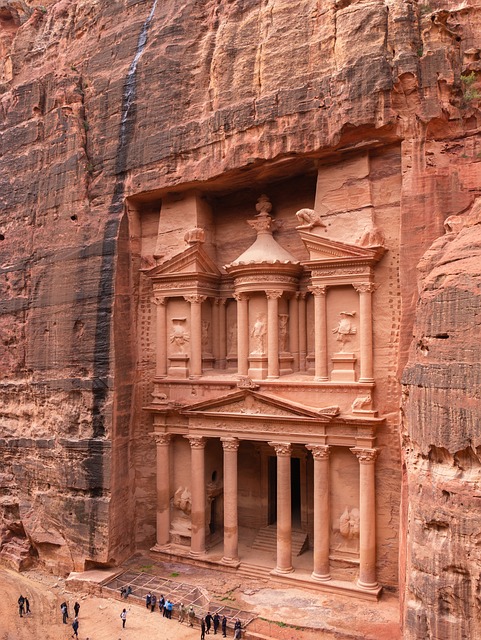 Pin
Pin Image Credit: 🌼Christel🌼 from Pixabay
The Siq: A Natural Wonder
The main entrance to Petra is the Siq, a dramatic and awe-inspiring natural sandstone canyon that stretches about 1.2 kilometers in length. Walking through this corridor, one can’t help but be overwhelmed by nature’s artistry – the walls reach up to 80 meters in height, and yet the path can narrow to a mere 2 meters across in places. The Siq with its curvaceous walls was formed by a natural splitting of the mountain due to tectonic forces and later smoothed by water erosion.
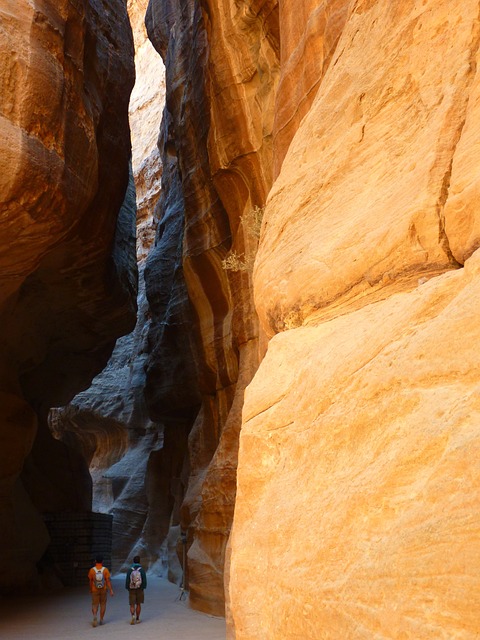 Pin
Pin Image Credit: Pixabay
Emerging into the Ancient City:
The walk through the Siq is a tantalizing build-up to your first view of Al-Khazneh, or the Treasury, as the canyon gradually opens to reveal Petra’s most iconic monument. This stunning facade, carved directly into the pink sandstone, is thought to be a mausoleum or crypt of Nabatean King Aretas IV, who ruled in the 1st century AD. The sight of the elaborately adorned facade, with influences from ancient Egyptian, Greek, and Roman architectural styles, is a testament to the Nabateans’ wealth and cultural connections.
Discovery and Architecture:
Once a thriving trading center and the capital of the Nabatean empire, Petra’s architecture is a mix of native traditions and the Hellenistic influences that came with the connections to other civilizations in the region. Beyond the Treasury, there are over 800 individual monuments in Petra, including buildings, tombs, baths, funeral halls, temples, arched gateways, and colonnaded streets. All are carved from the kaleidoscopic sandstone.
Cultural Interactions:
Exploring Petra is as much a cultural journey as a physical one. Engaging with the local Bedouins offers a glimpse into the living history of the site. Many of the Bedouins in Petra are descended from the Nabateans who built the city thousands of years ago. They have a unique connection to the place and can offer personal stories and insights.
The High Place of Sacrifice:
For the intrepid traveler, a hike to the High Place of Sacrifice is worthwhile. This sacred site offers panoramic views of the surrounding mountains and valleys. The ritual pathway, with its historical significance, is a testament to Petra’s spiritual importance.
Petra by Night:
An ethereal experience not to be missed is “Petra by Night,” a tour that leads you through the Siq to the Treasury, lit by over a thousand candles. The tranquility and the stark contrast of candlelight against the shadowy outlines of the ancient structures provide a reflective experience, transporting you through time.
Preservation and Impact:
While reveling in the awe-inspiring beauty of Petra, visitors should be mindful of the preservation efforts needed to maintain this world treasure. Weathering and increased tourism pose risks for the delicate structures. By respecting the site, tourists can contribute to the safeguarding of this wonder for future generations.
A visit to Petra is not simply a tick off the bucket list but stepping through the pages of history. It’s an exploration of a civilization that once commanded the crossroads of ancient trade routes, a marvel carved from the very earth, standing as a lasting testament to human ingenuity and artistry.
10. Take a Safari in Kruger National Park, South Africa
Spot the Big Five in one of Africa’s largest game reserves.
A safari in Kruger National Park is a quintessential African adventure teeming with wildlife encounters. As one of the continent’s most expansive and biodiverse protected areas, the park offers an unparalleled opportunity to spot the Big Five—lion, leopard, rhinoceros, elephant, and Cape buffalo—in their natural habitat.
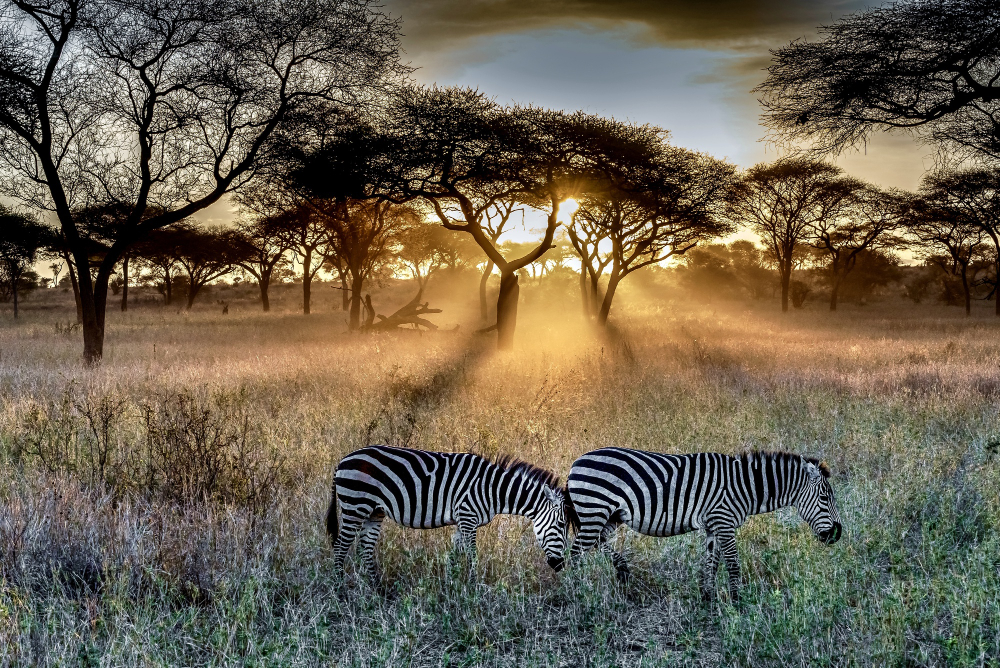 Pin
Pin Image Credit: wirestock from Pixabay
- The Big Five: These animals are named ‘Big Five’ not for their size, but for the difficulty posed in hunting them and the degree of danger involved. Today, fortunately, the hunting rifles are mostly replaced with cameras, and the thrill comes from photographing these majestic creatures in the wild.
- Kruger National Park: Stretching over nearly 20,000 square kilometers, Kruger spans a vast tapestry of ecosystems, from dense forests and dry savannahs to river systems teeming with life. This diversity sustains a myriad of species and supports healthy populations of the Big Five.
- Guided Safaris: To maximize the chances of witnessing all the Big Five, guided safaris are recommended. Rangers and trackers are expertly trained to read the signs of the wild, leading expeditions in open-top vehicles for unfettered views. They share insights into animal behaviors, ensuring that the safari is not only exhilarating but also educational.
- Conservation Efforts: Beyond tourism, Kruger is a bastion of conservation. Visitors are often informed of the park’s efforts in anti-poaching and species preservation, fostering an appreciation for the fragile coexistence between humans and wildlife.
- Wildlife Photography: For the shutterbugs, the park is a paradise. Unique lighting conditions, especially the golden hues of dawn and dusk, provide once-in-a-lifetime photo ops. The lush landscapes and the wildlife that inhabit them offer a tableau upon which both amateur and professional photographers can craft their art.
- Cultural Heritage: Beyond animals, the park is rich in archaeological history. Visitors can explore evidence of prehistoric human habitation, adding a layer of depth to the safari experience.
- Accommodations: From luxury lodges to rustic campsites, the park caters to a range of budgets and preferences, allowing guests to choose their level of comfort and adventure.
- Best Time to Visit: While the park welcomes visitors year-round, the dry winter months from May to September offer better wildlife viewing opportunities as animals congregate around water sources.
- Safety and Regulations: It’s critical to adhere to park rules to ensure safety and conservation. Speed limits and staying in vehicles in the presence of large wildlife are regulations strictly enforced for the safety of both animals and visitors.
- Local Communities: Kruger National Park also plays a pivotal role in local economies, with many communities involved in ecotourism initiatives. Supporting local guides and purchasing crafts can contribute positively to sustainable tourism and community empowerment.
Taking a safari in Kruger National Park is not merely a trip; it’s an immersion into the heart of wildlife conservation and an important educational journey that offers a profound connection with the animal kingdom and an in-depth appreciation of South Africa’s natural heritage.
11. See the Taj Mahal at Sunrise, India
Watch as the morning light bathes this marble wonder in a golden glow.
Witnessing the Taj Mahal at sunrise is an experience of timeless enchantment. As dawn breaks, the first rays of the sun cast a warm golden hue over the white marble, a spectacle that seems to breathe life into the monument. This iconic structure in Agra, India, stands as a testament to love, constructed by Emperor Shah Jahan in memory of his beloved wife Mumtaz Mahal.
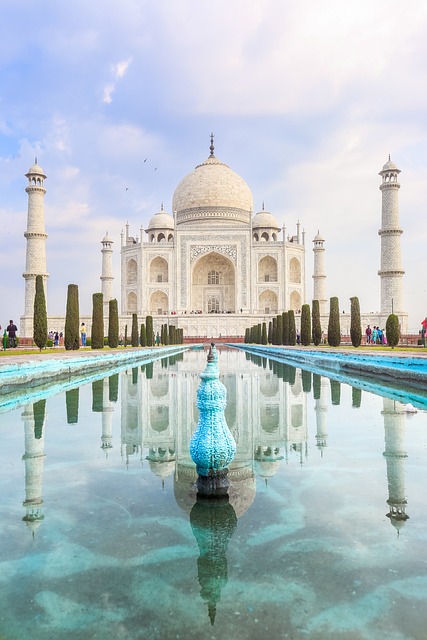 Pin
Pin Image Credit: Ruthie Derby from Pixabay
Witnessing the Taj Mahal at sunrise is an experience of timeless enchantment. As dawn breaks, the first rays of the sun cast a warm golden hue over the white marble, a spectacle that seems to breathe life into the monument. This iconic structure in Agra, India, stands as a testament to love, constructed by Emperor Shah Jahan in memory of his beloved wife Mumtaz Mahal.
As the sun ascends, the changing light seamlessly transforms the Taj Mahal’s appearance, revealing the intricate craftsmanship of the inlaid precious stones and the detailed calligraphy wrapping around its entrance. Witnessing this wonder at sunrise is advantageous for a few reasons. The temperature is cooler, and the daylight brings out a palette of colors in the semi-precious stones encrusted in the marble, which might be less discernible later in the day.
Moreover, visiting in the early hours allows for a less crowded experience, as the throngs of tourists usually arrive later. This serenity adds to the reflective beauty of the place, connecting visitors back to the 17th century, when this architectural treasure was painstakingly constructed by over 20,000 artisans.
The morning light playing on its surface is not just a visual treat but a moment of convergence between nature and man-made splendor.
Such a visit is not just a check on a travel list but a multi-sensory encounter with history, art, and architecture. The breathtaking panorama of the Taj Mahal surrounded by the lush Mughal garden and reflected in the still waters of the Yamuna at dawn truly is a bucket-list-worthy experience.
Touch upon the emotional impact it has on onlookers—how the sight becomes a poignant reminder of human expression and creativity’s potential. It’s a moment where time stands still and modern-day visitors can walk in the footsteps of emperors, reflecting on the impermanence yet undying legacy of great love.
12. Gaze upon the Grand Canyon, USA
Marvel at this vast natural masterpiece carved by the Colorado River.
Gaze upon the Grand Canyon in the USA and marvel at the vast, awe-inspiring panorama that spreads before your eyes. This natural masterpiece, carved painstakingly by the Colorado River over millions of years, is a geologic wonder that can stir the souls of visitors with its sheer magnitude and transcendental beauty.
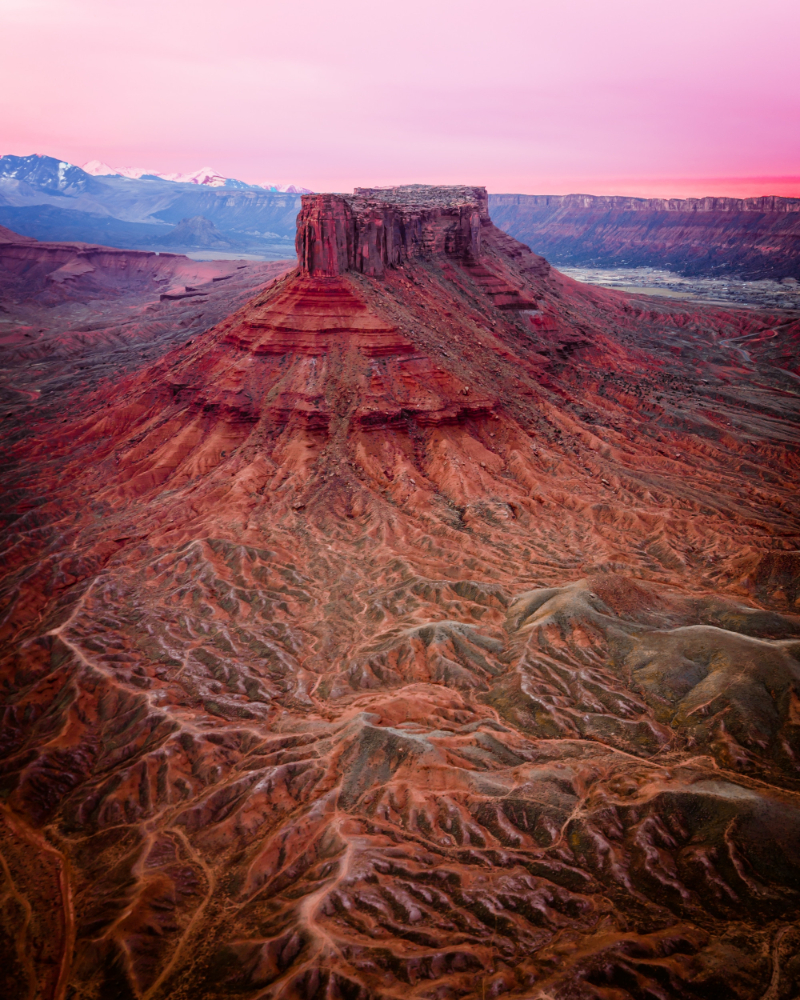 Pin
Pin Image Credit: wirestock from Pixabay
Stretching over 277 miles long, up to 18 miles wide, and over a mile deep, the Grand Canyon is a tapestry of intricate and colorful landscapes that tell tales of the Earth’s history. Each stratum of rock reveals a different era, acting as a timeline that dates back nearly two billion years. It’s not just a canyon but a library of geological phenomena preserved in stone.
At sunrise or sunset, the interplay of light and shadow paints the undulating cliffs and ridges in hues of red, orange, purple, and gold, casting an otherworldly glow that suggests the sublime artistry of nature. The viewpoints dotted along the rim of the canyon offer distinct perspectives of the vast chasm with every step providing a fresh vantage point and a unique photo opportunity. Some of the most famous viewpoints are Yavapai Observation Station, Mather Point, and the Desert View Watchtower, each offering a new angle to witness the grandeur of the canyon.
Descending into the canyon, whether by foot, mule, or along the Colorado River’s rapids, reveals the layered shades of the canyon walls up close. The micro-environments within each level of the canyon vary strikingly, from lush riparian vegetation near the water to harsh desert landscapes above.
The Grand Canyon also holds profound significance for the Native American tribes who have considered this land sacred for centuries. Their presence is woven into the very fabric of the canyon, with cultural sites and artifacts dotted throughout the park, offering a glimpse into the human history intertwined with this natural wonder.
When crafting the discussion for your article, highlight the emotional and spiritual impact the Grand Canyon imparts to its visitors. It’s a place where one can truly grasp the vastness of nature and the smallness of human concerns. It commands respect and necessitates silent contemplation.
Experiencing the Grand Canyon is to engage with nature’s most compelling masterpiece—it’s a place where time slows, and the drama of the Earth’s geological processes is on magnificent display. It’s not just something to see; it’s something to witness—a sensory and humbling encounter with one of the world’s greatest natural wonders.
13. Enjoy the Cherry Blossoms in Japan
Springtime in Japan brings the breathtaking bloom of sakura.
Spring in Japan is synonymous with the delicate beauty of cherry blossoms, known as sakura. Come late March to early April, a wave of pink and white sweeps across the country, a phenomenon that is both cultural and natural splendor. The brief blooming of sakura is celebrated nationwide with ‘hanami,’ traditional cherry blossom viewing parties where friends and families gather under canopied trees for picnics to admire the fleeting beauty.
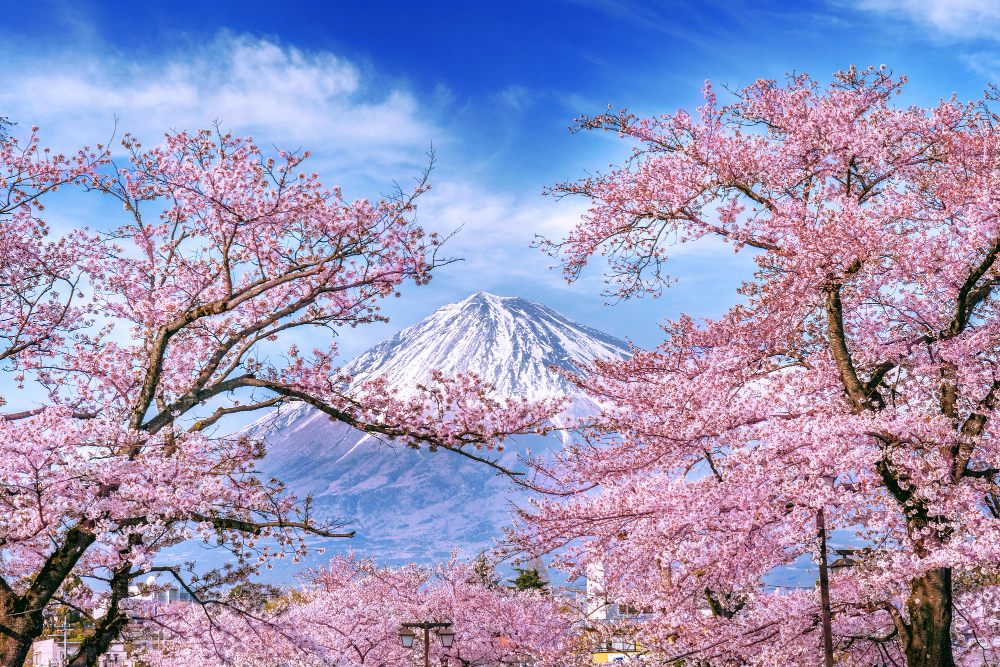 Pin
Pin Image Credit: tawatchai07 from freepik.com
The sakura bloom follows a warm front that sweeps from the southern islands of Okinawa in late January to the northernmost prefecture of Hokkaido by May. The Japan Meteorological Corporation even provides forecasts to predict the ‘sakura zensen’ or cherry blossom front. Kyoto, Tokyo, Nara, and Hiroshima are famous hanami spots where ancient and modern landscapes are framed by the blossom for a short while.
In the pink-dusted parks and temple gardens, the air is filled with a gentle fragrance. The blossoms, ranging from white to various shades of pink, are a testament to the transient nature of life in Japanese philosophy, echoing the impermanence and beauty of existence.
The experience extends beyond daytime; ‘yozakura’ is the term for nighttime cherry blossom viewing. Many places light up their sakura after dark, offering a different ambiance, with the illuminated blossoms against the night sky.
Japan’s rich cultural heritage intertwines with the sakura season; local delicacies are specially prepared and flavored with cherry blossoms or leaves. Limited-edition sakura goods flood the market, from sakura mochi to cherry blossom-themed beverages.
The cherry blossom season in Japan is not just a time to watch but to immerse oneself in a time-honored tradition. The celebration marks a renewal, and the ephemeral nature of the blooms serves as a reminder to pause and appreciate the present moment amidst the fast-paced rhythm of life.
14. Float in the Dead Sea
Experience the unique buoyancy and mineral-rich waters of this natural wonder.
Floating effortlessly in the Dead Sea is a unique natural phenomenon, thanks to its remarkable mineral content and hyper-salinity. The Dead Sea, bordering Jordan, Israel, and the West Bank, isn’t just the lowest point on Earth’s surface; it’s a sight of captivating beauty and serenity, offering a truly out-of-the-ordinary experience.
 Pin
Pin Image Credit: Ri Butov from Pixabay
The high salt concentration, nearly ten times that of the ocean, means that life cannot thrive in these waters, hence the name “Dead Sea”. Yet, this very characteristic provides an almost otherworldly floating sensation. The salt-rich water pushes you to the surface, making swimming more like gentle bobbing and providing an opportunity to recline as if on an invisible lounger, with the azure sky above and the surrounding pale desert landscapes stretching to the horizon.
The mineral-laden waters are renowned for their health benefits, attracting wellness tourists seeking remedies for various ailments. The unique composition of minerals such as magnesium, sodium, potassium, and bromide is believed to have therapeutic and cosmetic benefits – from improving skin conditions to easing aches and pains.
The experience includes more than just floating. Visitors often engage in the customary application of nutrient-rich black mud, scooped directly from the sea’s floor. Smearing this therapeutic mud over the body can cleanse and refresh the skin, leaving it rejuvenated once rinsed.
It’s not just about personal health: the surrounding environment of the Dead Sea area is steeped in history and cultural significance. Nearby are ancient sites like Masada, with its fortifications that tell tales of antiquity, and the Qumran Caves, where the Dead Sea Scrolls were discovered.
Environmental factors should be noted: The Dead Sea is shrinking. Water levels have been dropping at an alarming rate, a situation tied to human water management and climate shifts. This adds a poignant edge to visits as travelers today experience a site that future visitors may witness in a different state.
Precautions for visitors include avoiding swallowing the water or letting it contact the eyes, due to its high salinity. Small cuts can sting, and shaving right before entering the water is not recommended. Drinking plenty of fresh water is essential to avoid dehydration in the desert climate.
Floating in the Dead Sea isn’t just an item to tick off a bucket list; it’s a soujourn into stillness, a timeless ritual in a sea that has cradled civilizations, celebrated for its restorative gifts—a miraculous encounter with the buoyant waters that hold tales as ancient as Earth itself.
15. Climb Mount Kilimanjaro, Tanzania
Reach the roof of Africa on a challenging and rewarding ascent.
Climbing Mount Kilimanjaro in Tanzania is often described as a transformative experience, as it is not only a physical endeavor but a journey that challenges the spirit. Standing as the highest peak in Africa, Kilimanjaro towers at approximately 5,895 meters (19,341 feet) above sea level. It is known as the “Roof of Africa” and offers an incomparable opportunity for adventure and personal achievement.
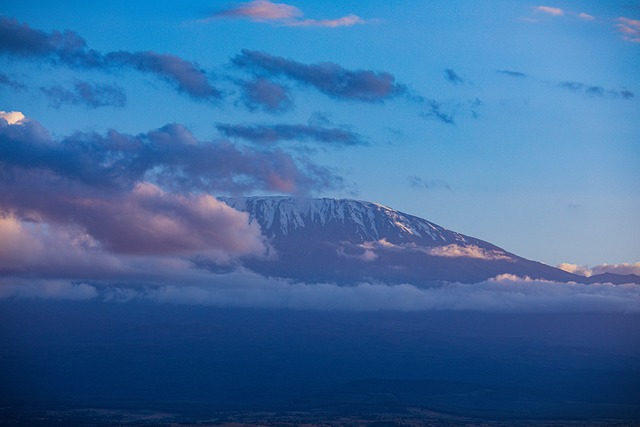 Pin
Pin Image Credit: Image by Antony Trivet from Pixabay
The journey to the summit passes through five distinct ecological zones: starting from cultivated lower slopes, ascending through lush rainforest, traversing alpine heath, climbing into a stark, lunar-like high desert, and finally reaching the icy Arctic zone at the peak.
Reaching Kilimanjaro’s summit is challenging due to the high altitude and the need for proper acclimatization. Despite the physical demands, the climb does not require technical mountaineering experience, making it accessible to determined trekkers who are reasonably fit. Suitable precautions and a well-paced ascent are crucial for a successful climb.
Several routes lead to the summit, including the popular Marangu, Machame, and Lemosho paths, each offering a different experience. Marangu provides hut accommodations, making it unique, while Machame is known for its scenic beauty, and Lemosho, although longer, offers a more serene climb with higher chances for acclimatization and summit success.
Summit night is an intense ordeal, typically starting at midnight or in the wee hours of the morning. Climbers tread the final stretch under the stars, combating fatigue, cold, and thin air. As dawn approaches and climbers reach the crater rim at Stella Point or Gillman’s Point, they often witness a breathtaking sunrise, the sky painted in hues of orange, pink, and purple, achieving an utterly rewarding experience. The final push to the summit, Uhuru Peak, is both a mental and physical battle against the altitude.
Standing at the peak, climbers are surrounded by glaciers and ice cliffs, a testament to the mountain’s vanishing ancient ice fields. The sense of accomplishment, coupled with the panoramic views of the African plains below, is an unrivaled experience that many describe as life-changing.
Climbing Kilimanjaro contributes profoundly to the local economy. Trekkers are encouraged to choose ethical tour operators who pay fair wages to their porters and guides, who are the unsung heroes of each expedition.
A Kilimanjaro climb is a major endeavor but with the proper preparation, support, and respect for the mountain’s environment and communities, it remains an attainable dream for many and a beacon for adventure travel in Africa.
16. Attend Carnival in Rio de Janeiro, Brazil
Join the colorful and lively spectacle that’s known worldwide.
Attending Carnival in Rio de Janeiro is to immerse oneself in a pulsating festival of exuberance that engulfs the entire city. Known as one of the largest parties on the planet, Rio’s Carnival is an explosion of culture, music, and shared joy.
 Pin
Pin Image Credit: Image by Antony Trivet from Pixabay
The Atmosphere:
Carnival in Rio creates an electrifying atmosphere that is both enchanting and infectious. The air is thick with anticipation, and as the rhythm of samba music fills the streets, a wave of dancers, locals, and tourists alike are carried away by the celebratory spirit that defines this remarkable festival.
Samba Parades:
At the heart of Carnival are the Samba Parades, orchestrated performances that are a spectacle of glittering costumes and masterful choreography. The city’s top samba schools spend months preparing for this moment, and when they finally take to the Sambadrome, an open-air parade area, they tell stories through dance, elaborate floats, and pounding drum rhythms. The grandeur and meticulous detail of their performances are a testament to their dedication to this cultural art form.
Street Festivities:
Beyond the Sambadrome, the streets are alive with ‘blocos’, smaller street parties and parades that welcome everyone. Each bloco has its own theme and mood, offering a more local and interactive experience. These parades showcase a variety of music genres and are perfect for those wanting to dance and mingle with Cariocas (Rio locals) in a more informal setting.
Costumes and Masks:
Carnival is also about dressing up – the more colorful and flamboyant, the better. Spectators and participants don costumes and masks that rival the plumage of tropical birds, turning the city into a kaleidoscope of colors. This tradition of dressing up dates back to Carnival’s origins when masks and elaborate outfits served as equalizers among different social classes.
The Sense of Unity:
Despite the sheer scale and wildness of Carnival, one of its most profound attributes is the sense of unity. It’s a time when differences are set aside, and people come together to celebrate life. The shared experience of music, dance, and festivity creates a collective heartbeat that resonates through the city streets, creating bonds that transcend the festivities.
Culinary Delights:
No Brazilian celebration would be complete without a mention of the food. Street vendors offer a variety of local snacks and drinks that are essential to the Carnival experience. Traditional foods like ‘acarajé’ (a dish made from peeled black-eyed peas formed into a ball and then deep-fried in palm oil) and ‘caipirinhas’ (a traditional Brazilian cocktail) are among the many treats to indulge in.
Attending Carnival in Rio de Janeiro is not just a spectator event; it’s a participatory celebration that engages all the senses. It’s a display of human joy and artistry unrivaled in its scale, a once-in-a-lifetime experience that captivates the soul and epitomizes the vibrant culture of Brazil.
17. Explore Angkor Wat, Cambodia
Wander through the world’s largest religious monument and its intricate carvings.
Angkor Wat, a temple complex in Cambodia, is a profound testament to the grandeur of the Khmer Empire. Enveloped by dense forest and echoing with the chants of a bygone era, it stands as the largest religious monument in the world.
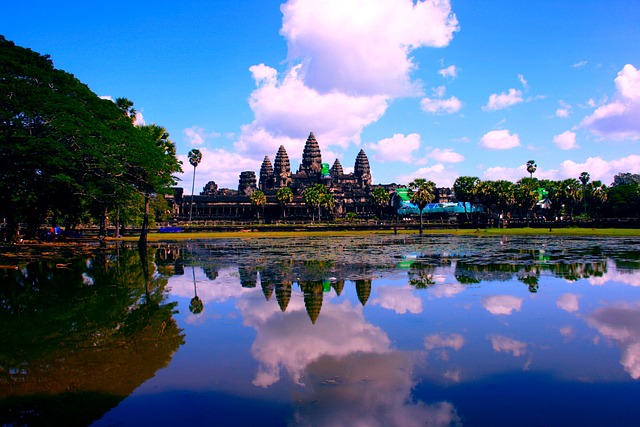 Pin
Pin Image Credit: Image by terimakasih0 from Pixabay
Explore the vast expanse of Angkor Wat, and you’ll find yourself wandering through a sprawling maze of stone, a complex designed to represent Mount Meru, the home of the gods in Hindu mythology. Originally constructed as a Hindu temple dedicated to the god Vishnu in the first half of the 12th century by King Suryavarman II, the complex gradually transformed into a Buddhist center.
The stone carvings that adorn Angkor Wat are nothing less than an anthology of stone, telling stories that blur the line between the divine and the earthly. Delicate apsaras (celestial nymphs) dance on the walls, frozen in time, while epic scenes from Hindu literature, such as the Ramayana and the Mahabharata, play out in elaborate bas-reliefs that serve as both decoration and narrative device.
As you roam through this ancient sanctuary, you’ll notice the symmetry and sacred geometry used to align and balance the temples architecturally. Each stone block was placed with intention, contributing to the grandeur and harmony of the monument. This architectural prowess is most evident at dawn, when the first rays of sunlight bathe the temple’s five iconic towers in a warm golden hue.
The aura of Angkor Wat is palpable, particularly at sunrise, as the monument reflects upon its moat, creating a mirage-like double that whispers of the universe’s duality. This moment, with its soft light and tranquil atmosphere, captures the magnitude of what human faith and ingenuity can achieve.
Visiting Angkor Wat is not just a walk through an archaeological marvel; it’s a pilgrimage through a living history that continues to stand proud as a symbol of Cambodia’s cultural heritage. It invites travelers to not merely see but also to feel the connection to the past, enriching their visit with a profound sense of awe and spirituality.
18. Spending a Night in a Castle
Spending a night in a castle is a dreamscape bucket list item that whispers tales of grandeur and transports one to a time of knights and nobility, of court jests and whispered intrigues.
It’s a lush immersion into history, an enchanting escape that tantalizes with the prospect of living like royalty, if only for a brief moment in time.
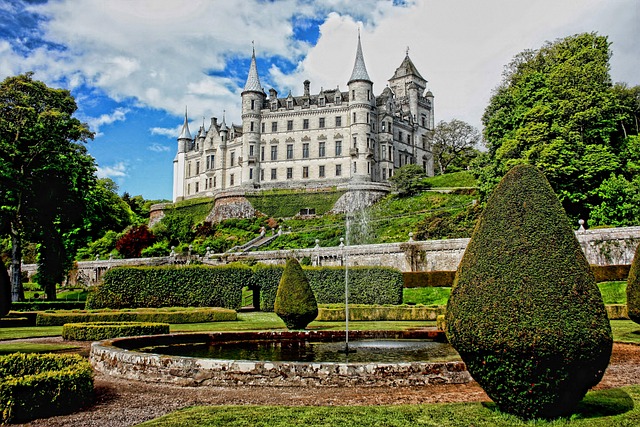 Pin
Pin Image Credit: Image by fotshot from Pixabay
Historical Enchantment: Castles are sedimentations of the past, monumental embodiments of history with walls that have withstood sieges and witnessed centuries unfold. Sleeping within these stone confines is like being swaddled in history, surrounded by the rich, complex tapestry of bygone eras. Every turret has a tale, every spiral staircase a secret, and every great hall echoes with the lingering voices of past feasts.
Architectural Awe: Castles are masterpieces of medieval architecture, boasting grand facades, soaring towers, and intricate details. To spend a night is to experience the awe of their design up close—the vaulted ceilings, the gothic windows, the carved woodwork. The opportunity to roam these halls without the press of daytime tourists permits a personal communion with the artistry of ancient craftsmen.
Royal Treatment: Many castles converted into hotels or bed-and-breakfasts offer the lavish experience of royalty. Four-poster beds, luxurious linens, opulent furnishings, and maybe even a personal butler contribute to an atmosphere of exclusivity. It’s the modern-day equivalent of a royal entourage, ensuring guests are pampered and their demands met.
Ghostly Whispers: For the thrill-seekers and lovers of the supernatural, spending a night in a castle might mean brushing shoulders with history in a more literal sense. Many castles boast a resident ghost or two, and a night spent in their halls offers a chance to encounter these ethereal inhabitants. It’s a spooky twist to the stay that excites many who are intrigued by the paranormal.
Scenic Surrounds: Castles are frequently nestled in extraordinary landscapes—gazing out over rolling hills, deep lochs, or rugged cliffs. The view at dawn and dusk can be stunning, adding a serene touch to the experience. Many castles feature gardens and grounds that are as much a part of the adventure as the stone corridors inside.
Exclusive Access: Staying the night often comes with the privilege of exploring rooms or areas not open to the regular public. It can be an intimate encounter with the most historic parts of the castle, like secret passages, ancient keeps, or private chapels, offering a deeper understanding and appreciation of the fortress.
Culinary Feasts: Dining in a castle can be an extravagant affair, with meals prepared by top chefs and served in grand dining halls. The cuisine is often locally sourced and may include traditional dishes that would have been common during the castle’s peak—culinary delights adding yet another layer to the authentic experience.
Period Activities: To complement the night, some castles host period-themed activities such as archery, falconry, or medieval banquets complete with minstrels and traditional entertainment. Such experiences round out the escapade, stoking the imagination and providing guests with a taste of noble pastimes.
Staying in a castle can be a unique and enchanting experience offering a blend of historical grandeur with modern luxury.
Here are several recommendations across different countries where you can spend the night:
- Ashford Castle – Ireland: Located in County Galway, this castle dates back to 1228 and offers a five-star luxury hotel experience, complete with a state-of-the-art spa, fine dining, and beautiful grounds.
- Amberley Castle- England: Nestled in the picturesque countryside of West Sussex, Amberley Castle has been converted into a luxurious hotel with each room uniquely designed to combine the historical features with contemporary comforts.
- Schlosshotel Kronberg – Germany: This castle hotel, located in Hesse, offers guests the chance to stay in a grand 19th-century castle with elegant rooms, a golf course, and beautiful gardens.
- Château de Bagnols – France: Situated in the heart of the Beaujolais, this chateau dates back to the 13th century and features meticulously restored rooms, a Michelin-starred restaurant, and a vineyard.
- Castello di Petroia – Italy: This medieval castle located in Umbria has been transformed into a boutique hotel and is surrounded by the Italian countryside, offering an authentic and tranquil experience.
- Parador de Alarcón – Spain: Overlooking the river Júcar, this 8th-century fortress is now a hotel located in the province of Cuenca. Expect unique historically decorated rooms and spectacular views.
- Dalhousie Castle Hotel – Scotland: Just a short drive from Edinburgh, this 13th-century fortress is Scotland’s oldest inhabited castle turned hotel and offers themed rooms, a fine dining restaurant, and a falconry experience.
- Pousada de Óbidos – Portugal: This small castle within the walled town of Óbidos was one of the first castles to be converted into a Historic Hotel of Europe, maintaining medieval features with modern comfort.
Booking a stay in a castle hotel usually requires planning in advance, especially during high season. Each castle offers a unique set of amenities, themes, and historical significance that can cater to various preferences, whether you’re looking for romance, adventure, or relaxation. Always check for the latest guest reviews and consider their on-site dining, activities, and the surrounding locale when making your choice.
Spending a night in a castle distills all these elements into a singular, breathtaking experience. It’s an adventure that’s as much about stepping back in time as it is about enjoying the luxurious eccentricities of the present. It’s a way to live out childhood fantasies, indulge in romanticism, and satisfy cultural curiosities—all within the span of one magical night.
19. Drive the Great Ocean Road, Australia
Coastal views and natural landmarks define this scenic route.
The Great Ocean Road in Australia is one of the world’s most scenic coastal drives, a 243-kilometer journey that offers a feast for the senses with its spectacular ocean views and a procession of natural landmarks. This route takes you along the southeastern coast between Torquay and Allansford, hugging the wild and windswept Southern Ocean.
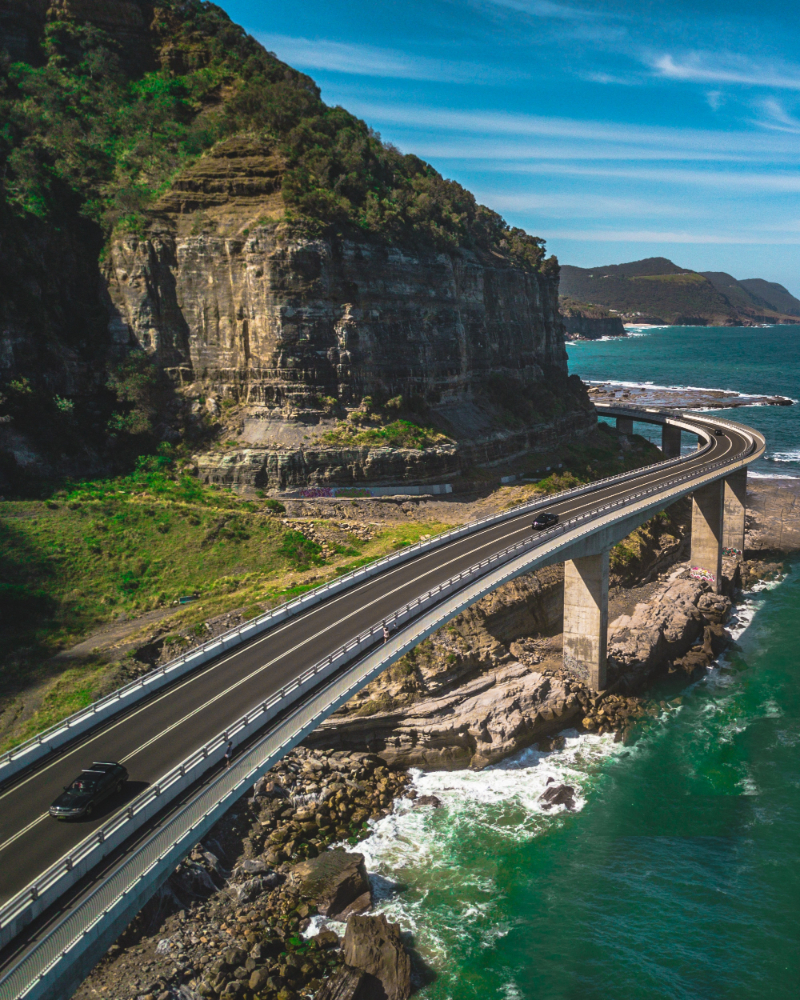 Pin
Pin Image Credit: wirestock from Pixabay
As you embark on this iconic drive, the road carves through lush rainforests and golden beaches, past cliffs, and idyllic seaside towns. The experience is not just about the destination but the journey itself, as you will find yourself constantly pulling over to absorb breathtaking vistas or to spot local wildlife, such as koalas nestled in eucalyptus trees or whales breaching offshore during their migration season.
A signature landmark along the route is the Twelve Apostles, a collection of limestone stacks that rise majestically out of the sea. Though the name suggests twelve, there are fewer remaining, yet their grandeur is undiminished, especially at sunrise or sunset when the rocks glow from golden to fiery red and deep purple.
The Great Ocean Road also passes through several national parks, including the Great Otway National Park. Here, you can stroll among ancient rainforests, admire the dramatic waterfalls, and walk the nature trails that reveal the rich biodiversity of the region.
Beyond the natural wonders, the drive offers cultural experiences as well—quaint towns with vibrant arts scenes, surf culture, and local cuisines specializing in fresh seafood and local produce. Engaging with these communities provides a glimpse into the laid-back lifestyle that characterizes Australia’s surf coast.
For an immersive experience, visitors often spend several days exploring, taking advantage of the campsites, bed-and-breakfasts, or luxury lodges that dot the coastline. By doing so, not only do they see the major sights, but they also uncover hidden gems, from secluded coves to artisanal eateries, each adding depth to the narrative of the Great Ocean Road.
Driving the Great Ocean Road is more than just a tick on a bucket list; it’s a journey that intertwines with the primal forces of nature, history, and the spirit of Australia. It’s a route that transforms from simply a road to a pathway leading to an unforgettable adventure.
20. Visit the Pyramids of Giza, Egypt
Stand in the shadow of these monumental tombs of pharaohs.
The Pyramids of Giza, just outside Cairo, have stood as monumental emblems of ancient Egyptian grandeur for millennia. As you approach the plateau where the pyramids reach for the heavens, there is a profound sense of entering a time capsule, with the landscape dominated by these colossal structures.
 Pin
Pin Image Credit: Pixabay.com
Standing in their shadows, you are dwarfed not just by their size but by the weight of history they carry. The Pyramids of Giza are the last remaining wonder of the ancient world, a testament to human ingenuity and the pursuit of immortality. The largest, the Great Pyramid of Khufu (Cheops), originally stood at 146.6 meters (481 feet), although now it’s slightly shorter due to the loss of the outer casing stones.
Visiting at dawn, the slanting light casts the pyramids in sharp relief against the brightening sky, their limestone capstones, where intact, brilliantly reflecting the sun’s early rays. The play of light and shadow over the pyramids’ angles and edges creates a mesmerizing geometric dance that can make time feel as if it’s standing still.
It’s a surreal experience to look upon the tombs of pharaohs such as Khufu, Khafre, and Menkaure, whose legacies have lasted far beyond their earthly reigns. The Great Sphinx of Giza, with its lion’s body and a human head—believed to represent Pharaoh Khafre—guards the plateau with a silent, enigmatic gaze.
While at the base of these ancient tombs, the scale becomes evident. Each block used to construct the Great Pyramid can weigh as much as 15 tons, and the sheer effort of the ancient Egyptians to assemble such a monument some 4,500 years ago leaves visitors in awe. It’s a humbling experience to walk around these pyramids, touching the same stones that were placed by workers orchestrated by an ancient civilization’s ambitious architectural plans.
The feeling of solemnity here is palpable, as you are not only in the presence of Egypt’s kings but surrounded by a necropolis that includes smaller satellite pyramids, mastaba tombs, and buried temples. The complexity of the site speaks to a highly organized society that was capable of marshaling and sustaining massive resources and labor forces over the decades required to build these structures.
A visit to the Pyramids of Giza is more than just a bucket-list checkoff; it’s an encounter with antiquity that brings us face to face with mankind’s eternal drive to defy death and time, to reach for something everlasting. The pyramids have kept their secrets for millennia, and as the sun tracks across the desert sky, their shadows shift on the sands, a reminder that, while empires rise and fall, some marvels endure.
For those contemplating the immeasurable span of human achievement, a visit to Giza is not merely a touristic excursion but a pilgrimage—to the very roots of civilization itself.
21. Hike through New Zealand’s Milford Track
Immerse yourself in the stunning fjordland ecosystems.
Exploring New Zealand’s Milford Track is a journey through the heart of Fiordland National Park’s raw and spectacular wilderness. This world-renowned hiking trail stretches approximately 53 kilometers through landscapes that embody the sublime beauty New Zealand is celebrated for.
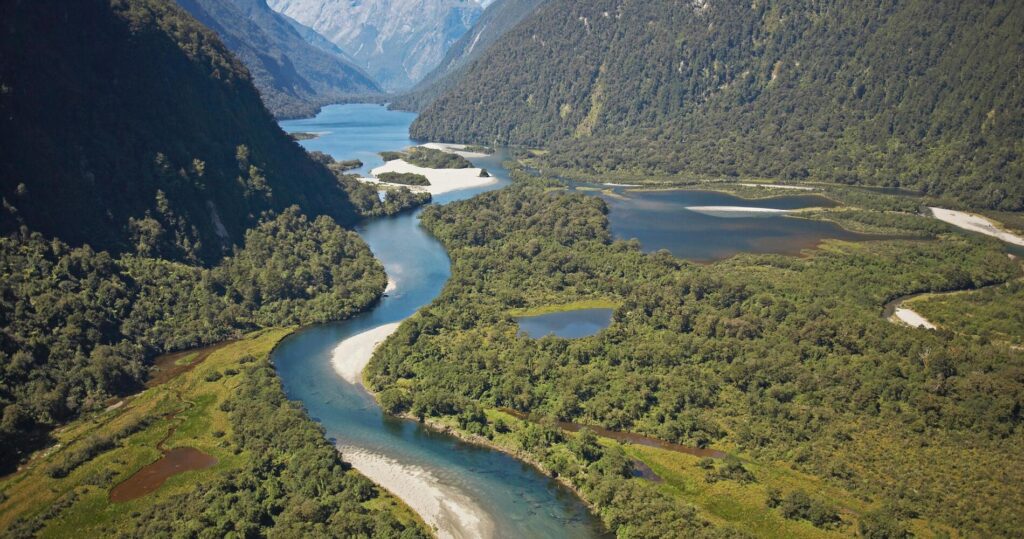 Pin
Pin Image Credit: NewZealand.com
As you immerse yourself in the fjordland ecosystems, you begin at the northern end of Lake Te Anau, working your way through lush rainforests that seem to murmur ancient tales with each rustle of their leaves. Walking beneath the towering canopies of rimu and beech trees, every step forward takes you deeper into a living mosaic of greenery, the air heavy with the scent of damp earth and verdant foliage.
The trail meanders alongside clear streams and across wooden suspension bridges spanning over thundering waterfalls. The roar of the cascades, such as the famed Sutherland Falls, one of the world’s tallest and most formidable, is a powerful reminder of nature’s might and majesty.
The path leads to stunning valleys carved by glaciers millennia ago. The dramatic landscape is a testament to the power of ice and time, a grand amphitheater of rugged cliffs and peaks that provide a home to keas, the world’s only alpine parrot, and the rare, iconic flightless bird – the takahe.
The Milford Track’s subalpine section unveils a different aspect of Fiordland’s diversified ecosystems. Here the bush line recedes, offering expansive views of open tussock fields and alpine herb meadows. The air is crisp, the skies a piercing blue that contrasts sharply with the stark, beautiful alpine terrain.
As you approach Mackinnon Pass, the track’s highest point, you stand amongst lofty mountain crags, where chamois and red deer might be glimpsed on distant slopes. Descending from the pass, the landscape transitions again – to the serene beauty of the Clinton Canyon and its rich, earthy coniferous forests.
Approaching the end of the track at the magnificent Milford Sound, the spectacular fjord comes into view, with its sheer rock faces rising vertically from the dark waters. Rain or shine, the vistas are shrouded in mist or bursting with sunlight, demonstrating the unpredictable and exhilarating nature of Fiordland’s weather.
Throughout your trek, the fragile and intricate fjordland ecosystems surrounding you are a constant reminder of the delicate balance that preserves their untouched allure. This is a place where human visitors are mere spectators and nature commands respect.
The Milford Track is more than a hike; it’s an all-encompassing exploration of pristine ecosystems and a physical communion with some of the most untouched environments on the planet. It’s a journey that leaves one humbled and exhilarated, a truly transformative experience within New Zealand’s stunning fjordland ecosystems.
22. Ride a Hot Air Balloon in Cappadocia, Turkey
Float above fairy chimneys and unique geological formations at dawn.
Venturing on a hot air balloon ride in Cappadocia, Turkey, is a voyage into a dreamscape, where the dawn whispers to the fairy chimneys and the earth tells tales of ancient eruptions. As the first streaks of light breach the horizon, you’re lifted gently into the cool, crisp morning air, the world beneath slowly awakening.
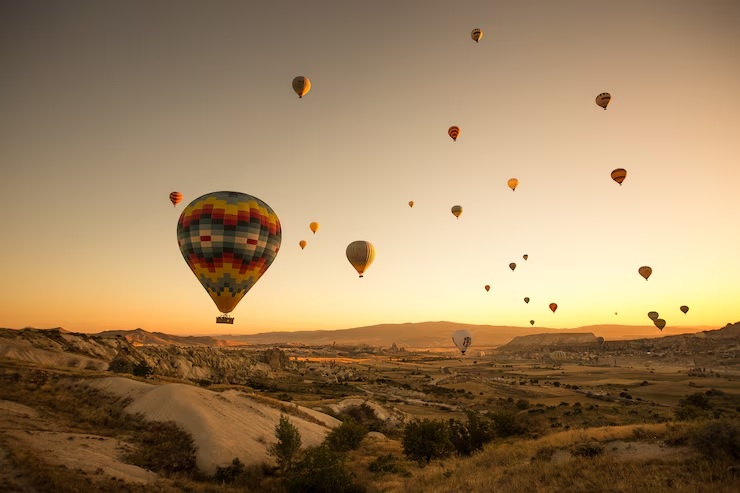 Pin
Pin Image Credit: NewZealand.com
Cappadocia’s unique geological formations are the heart of its otherworldly beauty. Millennia of volcanic activity and erosion sculpted this enigmatic landscape, crafting towers of stone, known as ‘fairy chimneys,’ that rise like seraphic spires from the earth. To float above them at dawn is to experience one of the most magical moments travel can offer.
As your balloon ascends, the pilot navigates through the soft winds, providing a panoramic 360-degree view. Below, the undulating valleys dotted with pigeon houses carved into the soft volcanic rock, ancient cave churches, and clusters of traditional homes blend seamlessly into nature’s grand tapestry.
The changing light of sunrise bathes the landscape in a warm glow, the shadows cast by the balloons dance across the textured terrain. The colors are ethereal—a muted palette that slowly turns vibrant as the sun climbs higher. In this tranquil realm, the silence is profound, punctuated only by the occasional roar of the balloon’s burner, adding a touch of warmth to the breeze.
Your flight is not just a visual feast but a timeless journey traversing the bounds between civilization and wilderness. It’s a testament to human ingenuity — not only the ancient civilizations that carved a life into these rocks but also the modern flight that now celebrates the beauty of this natural wonder.
Upon landing, the tradition of champagne toasts honors the successful flight, a celebration of the marvels witnessed from the sky, linking you to the age-old history of ballooning. As you raise your glass, you’re not just toasting your journey, but the spirit of Cappadocia itself, which has stood the test of time and continues to enchant visitors from above.
The hot air balloon ride in Cappadocia encapsulates the blend of thrill and peace, a majestic silence broken only by exclamations of awe. It’s an experience that etches itself into the memory, a serene communion with the break of day amidst a geological masterpiece.
23. Dive the Great Barrier Reef, Australia
Encounter the world’s largest coral reef system teeming with marine life.
Diving into the Great Barrier Reef, you are plunged into an underwater kaleidoscope, an ecosystem so vast and vivacious it’s visible from space. The reef, the world’s largest coral system, stretches over 2,300 kilometers along the coast of Queensland, Australia. It comprises nearly 3,000 individual reefs and 900 islands, a submerged universe waiting to be explored.
 Pin
Pin Image Credit: FitzroyIsland.com
As you descend, the surface’s shimmering blues give way to an explosion of color. You’re enveloped in an otherworldly realm where vibrant corals form sprawling cities, bustling with diverse marine life. The Great Barrier Reef is an epicenter of biodiversity, home to thousands of species, some of which are found nowhere else on Earth.
Encountering this underwater metropolis, you’re likely to lock eyes with the curious potato cod or the amiable clownfish peering out from its anemone home. The reef’s inhabitants range from tiny neon damsels to the imposing, yet gentle, whale sharks. Glide alongside sea turtles as they gracefully navigate the coral channels, and watch as parades of pelagic fish like trevallies and barracudas sweep past you in shimmering schools.
Coral gardens here are not mere backdrops but the pulsing heart of the reef community. Their shapes are as varied as their palettes, with branching staghorn and elkhorn corals, massive brain corals, and delicate sea fans and feathers. This underwater tapestry sways to the rhythm of the currents, a silent symphony played out in slow motion.
Beyond the beauty and spectacle, the reef is a scientific and ecological treasure. Each dive is an encounter with a complex, interdependent ecosystem. Vibrant coral polyps are at work, forming the backbone of this marine metropolis, while cleaning stations where smaller species like shrimp and wrasse service larger fish highlight the interconnectedness of reef life.
The Great Barrier Reef is not just a mecca for divers; it is a living library, a repository of environmental interactions, where the climate and oceanography of the past are recorded in coral skeletons, and the potential future of our oceans can be studied amidst the challenges of climate change and coral bleaching.
Diving the Great Barrier Reef is a transformative experience, akin to stepping onto another planet where each dive site offers unique encounters. From the world-renowned Ribbon Reefs to the remote Coral Sea atolls, each site brims with life and adventure. The iconic Cod Hole, the dramatic walls of Osprey Reef, or the Whitsunday’s fringing reefs—each dive is a chapter in an unwritten underwater epic.
By conserving this magnificent site, efforts continue to ensure that future generations will also be able to witness this aquatic wonderland. As divers surface, they carry with them not just memories but also a renewed sense of guardianship for one of our planet’s most exquisite and delicate marvels.
24. Explore the Venice Canals, Italy
Glide through the historic waterways in a traditional gondola.
Exploring the Venice canals in Italy is an experience that embodies romance, history, and a unique maritime tradition. As one glides through the serpentine waterways of this storied city in a traditional gondola, one is transported into a world that beautifully blends the past with the present.
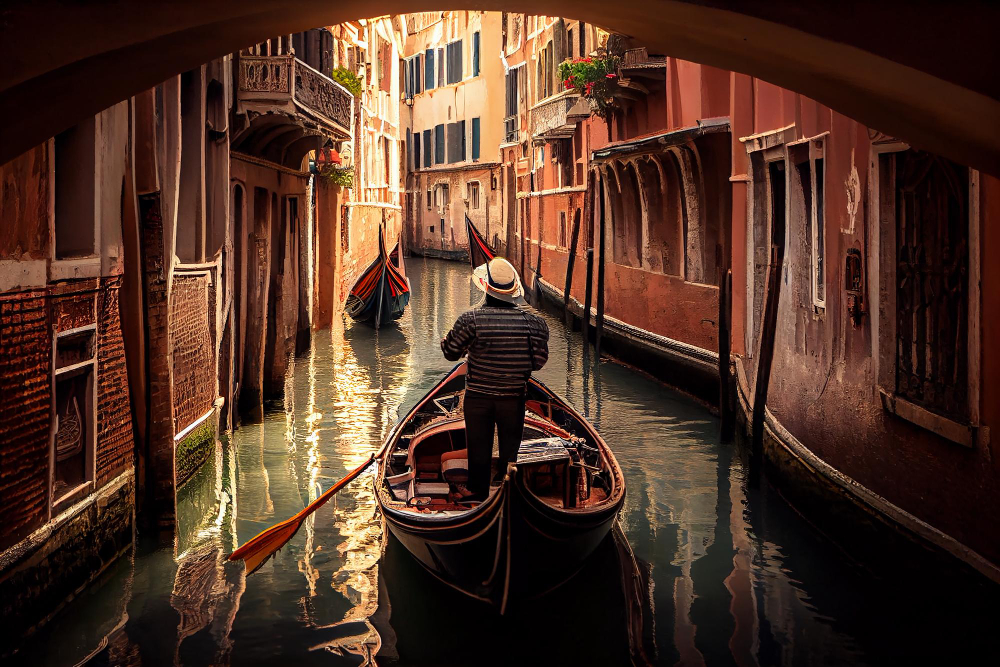 Pin
Pin Image Credit: vecstock from Freepik.com
Historic Waterways: The canals serve as the streets of Venice, a city ingeniously built upon the waters of the Adriatic Sea. With origins stretching back over a millennium, the labyrinthine canals were designed to accommodate the flow of water from the rivers to the sea, simultaneously creating a perfect setting for the Venetians to construct a city in harmony with the tides.
Traditional Gondolas: The gondola is a symbol of Venice. These slender, black boats have been the primary mode of transport along the narrow canals for centuries, evolving from being a means of everyday conveyance to a beloved attraction. Gondoliers, often seen in their traditional attire of a striped shirt and straw hat, expertly navigate these 11-meter-long crafts with a singular oar, a technique refined through generations.
Canal Routes: The Grand Canal, the main artery of Venice’s waterways, teems with vaporettos, water taxis, and private boats. But it is the quieter, smaller canals that often capture the true essence of Venice. The subdued splash of the gondola’s oar cutting through the water, the sudden appearance of a small piazza or the glimpse of an ornate bridge reflecting in the canal water – these are the moments that stay with visitors forever.
Historical Significance: The architecture lining the canals tells the history of Venice, from the Byzantine and Gothic periods to Renaissance and Baroque. The facades of palaces and churches directly facing the water illustrate the wealth and artistry that has coursed through the city. Each building, bridge, and square has its own story, contributing to the rich cultural tapestry of Venice.
Cultural Experience: A gondola ride in Venice is not just a simple boat trip; it’s an immersive cultural experience. It is about the interaction with the gondolier, whose anecdotes and knowledge of the city add depth to the journey. It’s the melody of Italian being spoken on the bridges and along the banks, the operatic notes drifting from a nearby window, and the tantalizing smells wafting from the osterias.
To explore the Venice canals is to understand the soul of the city. Whether brushed by the golden hues of sunset or illuminated by a soft lamp’s glow at dusk, the canals offer an enchanting vision of Venice that is timeless, an artistic masterpiece carved by the hands of history and maintained by the love of its people.
25. Join the Holi Festival, India
Be part of the vibrant festival of colors and celebrate the triumph of good over evil.
Embrace the spirit of Holi, India’s most vibrant and exuberant festival. Known as the Festival of Colors, Holi is not only a celebration that paints the skies with the hues of joy but also an ancient tradition symbolizing the victory of good over evil. This jubilant occasion marks the end of winter and the abundance of the upcoming spring harvest season.
 Pin
Pin Image Credit: Freepik.com
Origins and Significance: Holi has roots in various ancient Indian mythologies. Predominantly, it celebrates the legend of Holika and Prahlad, which illustrates the triumph of devotion and righteousness over arrogance and malice. A bonfire, known as Holika Dahan, is lit on the eve of Holi in memory of this legend, signifying the burning away of evil.
The Celebrations: Holi festivities kick off with the lighting of bonfires, where people gather to perform rituals, sing, and dance. The following day, known as Rangwali Holi, is when the real excitement begins. The air is filled with powders of every imaginable color as people smear gulal (colored powder) on each other, splash water, and drench one another with water balloons. This playful combat is accompanied by the sounds of dholaks (traditional drums), creating a rhythmic backdrop for the revelry.
Cultural Fabric: The festival brings together people from all walks of life, breaking down social barriers. Personal and societal differences dissipate as everyone is coated in the same vibrant palette. Traditional sweets like gujiya, thandai (a cool, flavored drink), and various other dishes add to the sensory delight of Holi.
Unity in Diversity: For a country as diverse as India, Holi is a binding thread. It’s a time when people forget their quarrels, embrace forgiveness, and express love for friends and family. The essence of Holi lies in its power to unite through the simple yet profound act of spreading colors.
Holi is an unforgettable experience, an invitation to unleash your inner child and indulge in pure delight. Join this festival of colors in India and become a part of an event that not only symbolizes the victory of good over evil but also exemplifies the joy of togetherness and the spirit of inclusivity. The experience promises to leave you with a heart full of happiness and memories as vibrant as the colors of Holi.
Conclusion
To complete these 25 experiences, consider ecological footprint, immerse yourself in local cultures, and always travel responsibly. Each journey holds the promise of new insights and life-changing impressions, reminding us that the world’s wonders are as boundless as the skies above. Whether you seek tranquility or adrenaline, these 25 epic experiences are ticking invitations to step out of your comfort zone and into the heart of the planet’s most captivating destinations. Set your sails, lace your boots, and prepare for a voyage that will etch itself into your memory forever.

